Water & Wastewater
Achieving financial sustainability
Roads & Bridges
Bridging the gap in steel
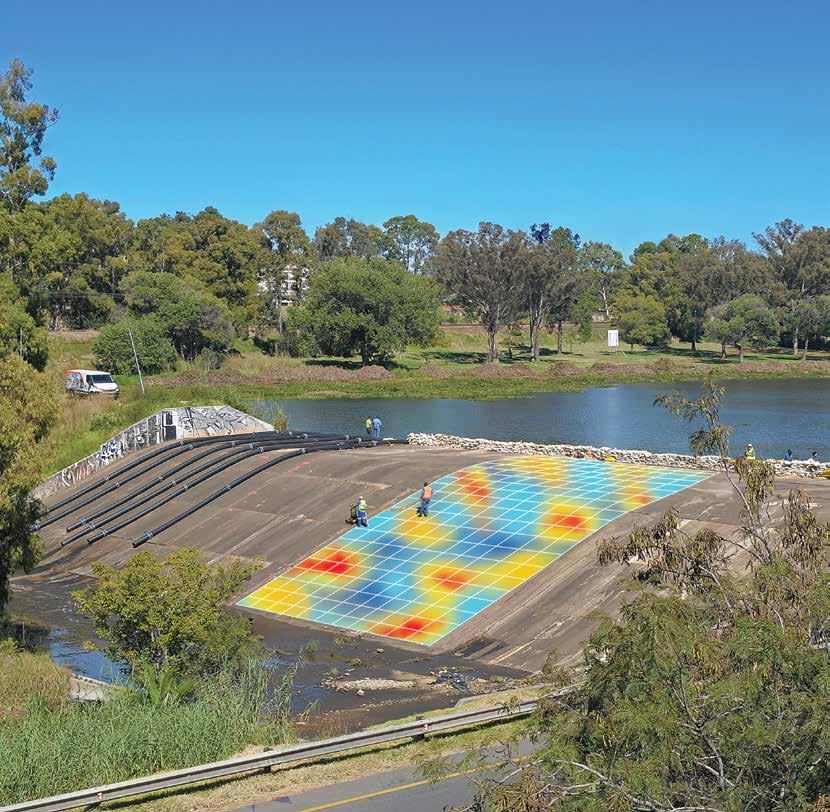

IN THE HOT SEAT
“Our strategy has always been to focus on larger-scale projects that put our skills to the test; however, no project has ever been too small for Nyeleti, and we will continue to take up each and every challenge that comes our way.”
IMESA The official magazine of the Institute of Municipal Engineering of Southern Africa www. infrastructurenews.co.za infrastructure development • m aintenance • service delivery
Pine Pienaar executive director, nyeleti consulting ISSN 0257 1978 Volume 44 No. 6 • June 2019 • R50.00 (incl. VAT)
ORSCO GPR
at Middle
survey
Lake Dam
Consistent quality requires consistent excellence ...
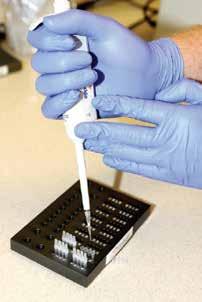
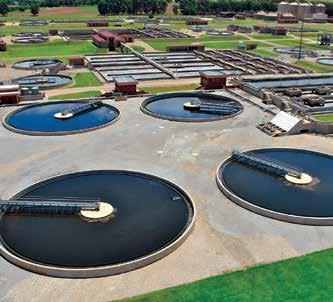

... in every area of wastewater management.
Serving both the public and private sectors, ERWAT promotes a healthy environment by providing cost-effective wastewater treatment solutions through innovative technologies. It specialises in sustainable, quality wastewater services, backed by focused technical, maintenance and engineering services. An ISO/IEC 17025 accredited laboratory renders a wide variety of specialised analyses, while industrial wastewater quality management assessments and advice are also offered.
East Rand Water Reg. No. 1992/005753/08
(Association incorporated in terms of section 21)
GPS Co-ordinates:
Address: Hartebeestfontein Office Park, R25, Bapsfontein/Bronkhorstspruit, Kempton Park.
Tel: +27 11 929 7000
E-mail: mail@erwat.co.za
www.erwat.co.za
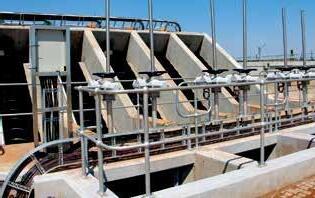
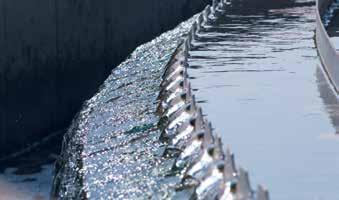
ERWAT EXCELLENCE
WASTEWATER
IN
S 26° 01’ 25.8”
E 28° 17’ 10.0”
and
uppe marketing A13900

IN THE HOT SEAT


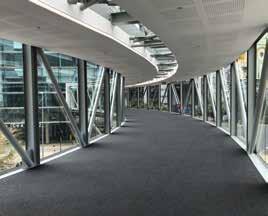


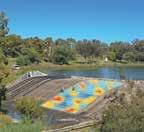
reported from a ground-penetrating radar survey will help to pinpoint anomalies in the concrete spillway structure at Middle Lake Dam in Benoni, which recently suffered significant erosion damage. This emergency situation required urgent action to reduce the risk of potential failure of the
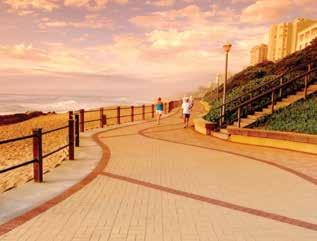
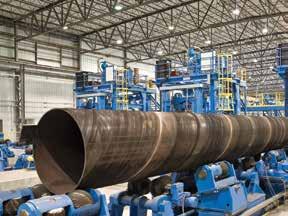
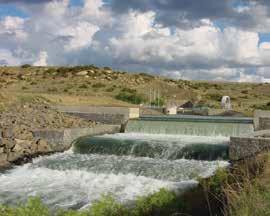
volume 44 no. 6 June 2019 IMESA of Municipal Engineering of Southern Africa infrastructurenews.co.za IN THE HOT SEAT “Our strategy has always been to focus on larger-scale projects that put our skills to to take up each and every challenge that comes our way.” Pine Pienaar ExecutiveDirector,NyeletiConsulting Water & Wastewater Achieving financial sustainability Roads & Bridges Bridging the gap in steel ORSCO GPR survey at Middle Lake Dam Regulars Editor’s comment 3 President’s comment 5 Africa round-up 9 Index to advertisers 56 Cover Story Remediating Middle Lake Dam 6 Hot Seat Two decades of excellence 10 Sustainability Smart cities are green cities 12 Clay pavers promote mobility 15 Driving building sustainability 17 Roads & Bridges Bridging the gap in steel 18 Bridging rural routes 22 Reinstating a vital port connection 23 Public Lighting Lighting the way 24 The data
P6 15 INSIDE SuStainability Clay pavers promote mobility A visionary leader in its field, Nyeleti Consulting celebrates its 20th birthday in 2019. IMIESA speaks to executive director Pine Pienaar about the company’s successes and its future ambitions. P10 26 39 18 MeterS, PiPeS, PuMPS & ValVeS Spiral welded pipes ideal for municipal works roadS & bridgeS Bridging the gap in steel daMS & Water Storage Tunnel designers prep for Phase II
spillway.
Meters, Pipes, Pumps & Valves Spiral welded pipes ideal for municipal works 26 Genuine parts deliver 28 PVC-O advances 29 Exploring the future of plastic pipes 31 Key benefits of prepaid water 32 Water & Wastewater Capacity boost for Zuikerbosch 33 Creating a financially sustainable sector 34 Conflicting data impacts RO deliver 36 Dams & Water Storage Tunnel designers prep for Phase II 39 SASTT Trenchless News Key considerations for trenchless projects 40 Cement & Concrete Moving mountains for sport 43 The potential and challenges of RCC 44 Slagment is green 47 Insurance Engineering and construction insurance in a challenging market 49 Transport, Logistics, Vehicles & Equipment Screencore launches in SA 51 Custom-built plant boosts capacity 53 Stronger and faster 54


LEADERS IN SMART WATER MANAGEMENT www.utility-systems.co.za +27 (0) 31 700 4143 enquiries@utility-systems.co.za Providing smart solutions for the responsible management of the world’s most valuable resource… water
MANAGING EDITOR Alastair Currie
SENIOR JOURNALIST Danielle Petterson
JOURNALIST Nombulelo Manyana
HEAD OF DESIGN Beren Bauermeister
CHIEF SUB-EDITOR Tristan Snijders
CONTRIBUTORS Alaster Goyns, Nico-Ben Janse van Rensburg, Randeer Kasserchun, Keitumetse Moumakoe, Bryan Perrie, Marcus Thulsidas
OPERATIONS & PRODUCTION MANAGER
Antois-Leigh Botma
PRODUCTION COORDINATOR Jacqueline Modise
FINANCIAL MANAGER Andrew Lobban
BOOKKEEPER Tonya Hebenton
DISTRIBUTION MANAGER Nomsa Masina
DISTRIBUTION COORDINATOR Asha Pursotham
SUBSCRIPTIONS subs@3smedia.co.za
PRINTERS Paarl Media KZN +27 (0)31 714 4700
ADvERTISING SALES
Jenny Miller Tel: +27 (0)11 467 6223
Email: jennymiller@lantic.net
PUBLISHER Jacques Breytenbach
Novus Print (Pty) Ltd t/a 3S Media
46 Milkyway Avenue, Frankenwald, 2090
PO Box 92026, Norwood 2117
Tel: +27 (0)11 233 2600 Fax: +27 (0)11 234 7274/5
www.3smedia.co.za
ANNUAL SUBSCRIPTION: R600.00 (INCL vAT)
ISSN 0257 1978 IMIESA, Inst.MUNIC. ENG. S. AFR.
© Copyright 2019. All rights reserved.
IMESA CONTACTS
HEAD OFFICE:
Manager: Ingrid Botton
P.O. Box 2190, Westville, 3630
Tel: +27 (0)31 266 3263
Fax: +27 (0)31 266 5094
Email: admin@imesa.org.za
Website: www.imesa.org.za
BORDER
Secretary: Celeste vosloo
Tel: +27 (0)43 705 2433
Fax: +27 (0)43 743 5266
Email: celestev@buffalocity.gov.za
EASTERN CAPE
Secretary: Susan Canestra
Tel: +27 (0)41 585 4142 ext. 7
Fax: +27 (0)41 585 1066
Email: imesaec@imesa.org.za
KWAZULU-NATAL
Secretary: Ingrid Botton
Tel: +27 (0)31 266 3263
Fax:+27 (0)31 266 5094
Email: imesakzn@imesa.org.za
NORTHERN PROvINCES
Secretary: Rona Fourie
Tel: +27 (0)82 742 6364
Fax: +27 (0)86 634 5644
Email: np@imesa.org.za
SOUTHERN CAPE KAROO
Secretary: Henrietta Olivier
Tel: +27 (0)79 390 7536
Fax: +27 (0)86 629 7490
Email: imesasck@imesa.org.za
WESTERN CAPE
Secretary: Michelle Ackerman
Tel: +27 (0)21 444 7114
Email: imesawc@imesa.org.za
FREE STATE & NORTHERN CAPE
Secretary: Wilma van Der Walt
Tel: +27 (0)83 457 4362
Fax: +27 (0)86 628 0468
Email: imesafsnc@imesa.org.za
A greener powered solution
Historically, our electricity has been derived exclusively from coal-fired power stations, with the exception of Koeberg in Cape Town, which remains Africa’s sole nuclear producer, predominantly serving the Western Cape region.
Although the renewables market is a definite step in the right direction, over the medium term, the bulk of national energy demand will continue to be powered by coal, which remains a cheap energy source. South Africa has abundant coal resources, with untapped reserves projected to last well beyond 100 years. Across the border, Botswana has massive untapped reserves that will last much longer. That’s good news for our mining sector, and South Africa’s macro economy in terms of the export market to key buyers, which include India, via the Richards Bay Coal Terminal. Coal can be green, when power plants are designed using the latest lower-emission clean coal technologies. Plus, as the World Coal Association states, “38% of the world’s electricity and 71% of the world’s steel is (still) produced using coal.” Coal also has other downstream benefits that are used to formulate products like petroleum, polymers, solvents and bitumen.
Maintaining the power balance is not just about the continuation or discontinuation of coal. Overall, it’s about the best power delivery options and affordability. This is top of mind for every consumer, and especially local and international investors planning expansions or greenfield projects. Financial markets have responded positively to the proposed unbundling of Eskom into niche-focused entities. Hopefully, a firm decision in this respect will be announced shortly following the establishment of the new cabinet. In the meantime, electrical distribution infrastructure needs to be modernised and maintained.
Tariff increases and the Carbon Tax
For all consumers, the new electricity tariff increases are a concern, since further price adjustments could still be passed on by municipalities during the balance of 2019. That will definitely motivate consumers to look for ways to cut down further on consumption costs.
Now, the introduction of South Africa’s new Carbon Tax Act (No. 15 of 2019) since 1 June 2019 adds a further incentive; although its primary goal is the reduction of greenhouse gas emissions, based on the polluter-pays principle.
The intention is to motivate users, particularly industrial ones, to adopt cleaner technologies. During Phase I (running until 31 December 2022), tax-free emissions allowances will range from 60% to 95% and apply exclusively to what are defined as Scope 1 emitters. The second phase runs from 2023 to 2030.
From 5 June, everyone owning a vehicle is immediately affected by the Carbon Tax, following an additional fuel price levy of R0.09 and R0.10 for petrol and diesel, respectively. Taxation collected during Phase I will generate billions in revenue for the state.
Hopefully, a balance of the taxation monies raised will be used to fund renewables projects. That would also speed up the approval of independent power purchase agreements, accelerating the large-scale growth of a new and sustainable green industry. Over time, it could eventually replace fossil fuels in the energy mix, but coal still has its place for the foreseeable future.
Alastair





Cover opportunity
EDITOR’S COMMENT To our avid readers, check out what we are talking about on our website, Facebook page or follow us on Twitter and have your say.
In each issue, IMIESA offers advertisers the opportunity to get to the front of the line by placing a company, product or service on the front cover of the journal. Buying this position will afford the advertiser the cover story and maximum exposure. For more information on cover bookings, contact Jenny Miller on +27 (0)11 467 6223.
All material herein IMIESA is copyright protected and may not be reproduced either in whole or in part without the prior written permission of the publisher. The views of the authors do not necessarily reflect those of the Institute of Municipal Engineering of Southern Africa or the publishers. Infrastructure News @infrastructure4 IMESA official Institute Engineering Africa www.infrastructurenews.co.za INFRASTRUCTURE DEVELOPMENT MAINTENANCE IN THE HOT SEAT strategy has always been focus on larger-scale projects put our to test; however, project ever been small for Nyeleti, and we continue up each every challenge that comes way.” Pine Pienaar Director, Consulting 1978 R50.00 Water & Wastewater Achieving financial sustainability Roads & Bridges Bridging the gap in steel ORSCO GPR survey at Middle Lake Dam IMIESA June 2019 3

HOW DOES UNRELIABLE WATER SUPPLY IMPACT YOUR PEACE OF MIND?
INCREASE RELIABILITY WITH GRUNDFOS SOLAR SQFLEX PUMPS

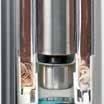
POWER FROM ANY SOURCE
A built-in frequency converter ensures that the motor runs on both AC and DC from power sources such as solar panels and wind turbines.
GRUNDFOS SUBMERSIBLE SOLUTIONS SOLAR PUMPING SOLUTIONS MADE EASY
Grundfos offers a range of solar pumping solutions that can be tailored to suit almost any application or local conditions: for remote off-grid areas, Grundfos solar pumping solutions offer many benefits over traditional grid-based or diesel powered pumping systems including
• Easy installation
• Low maintenance
• Low operating costs
For more information or to find your nearest Grundfos Distributor, visit za.grundfos.com/campaigns/submersible-solutions

Trademarks displayed in this material, including but not limited to Grundfos, the Grundfos logo and “be think innovate” are registered trademarks owned by The Grundfos Group. All rights reserved. © 2019 Grundfos Holding A/S, all rights reserved.

Work stoppages and unemployment

Now that the General Election has passed, the hard work of implementing government’s multifaceted action plan begins again in earnest. It’s another exciting stage in South Africa’s democracy and the construction sector will be watching closely to gauge the pace of infrastructure delivery.
The scarcity of work in our sector has resulted in intensified competition; however, there has also been another unexpected consequence in the form of work stoppages on projects. Community members, local business forums, the unemployed, as well as unsuccessful bidders are increasingly disrupting awarded projects in progress, demanding a share of the work – frequently around 30% of the contract value. Some of these disruptions have turned violent, threatening the safety of construction workers and sometimes resulting in the destruction of valuable equipment and plant. On top of that is the delay in implementing affected projects, which has a downstream financial impact on contractors, municipalities


and the economy. The situation also negatively hampers investor confidence in our country, at this critical time.
IMESA and other associations forming part of the South African Forum for Engineering are now rallying together to more effectively lobby government and find a solution to this impasse. That includes working closely with key stakeholders like Sanral and the Department of Public Works to nip this issue in the bud. Projects awarded by both these entities have experienced an especially sharp increase in construction ‘mafia-type’ behaviour.
Butcher Matutle, registrar, South African Council for the Project and Construction Management Professions, recently stated that “such tactics cannot be condoned, and can only be classified as acts of criminality. Greater dialogue should go a long way in addressing the problems that are plaguing the construction industry.”
Building capacity
Fixing the problem won’t happen overnight given the high rate of unemployment in South Africa and the present macro- and micro-economic environment. According to Statistics South Africa’s Q1 2019 Quarterly Labour Force Survey (QLFS), around 27.6% of the country’s population is out of work. Compounding this scenario is the constant increase in the working-age population entering the market within a trading environment where employment opportunities are declining across most industries. Leading the sectors in this regard is construction, which shed 142 000 people in Q1 2019.
The QLFS report presents an especially alarming stat when it comes to the youth. It
states, “Of the 20.3 million young people aged 15 to 34 years, 40.7% were not in employment, education or training.” Clearly that’s a serious concern and a renewed focus on infrastructure roll-outs is part of the solution in building the capacity needed to create new job opportunities.
As municipal managers and engineers, we have a direct and indirect role in revitalising construction and infrastructure activities, ensuring that we create the right framework for local and foreign direct investment within our increasingly urbanised landscape. That includes the development of public-private partnerships that stimulate development in key sectors like ICT, manufacturing and tourism. A number of metros are also investigating the implementation of integrated public land development programmes for mixed-use projects. The growth in the renewable energy sector also holds the promise of new work.
South Africa invested around R3 trillion over the past two decades on public infrastructure. More recently, though, there has been a contraction brought about by budget cuts; however, as the Auditor General confirms, a number of municipalities are still underspending on their infrastructure budgets. The end goal should be to improve efficiencies in the tender process to increase the flow of project awards that are budgeted for. Hopefully, that will alleviate the present work stoppage situation.
Our commitment as IMESA is to proactively engage within the three spheres of government to deliver the best value as municipal engineers.
IMESA
P RESIDENT ’ S COMMENT IMIESA June 2019 5
Randeer Kasserchun, president, IMESA

Remediating Middle Lake Dam
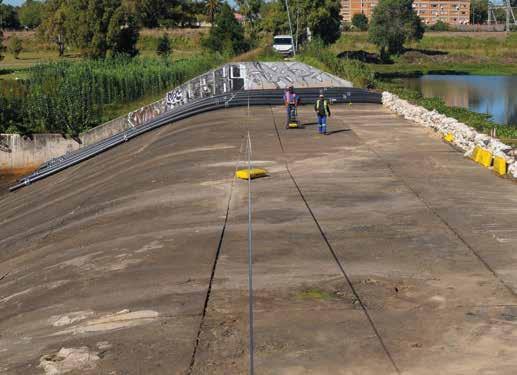
The data reported from a ground-penetrating radar survey will help to pinpoint anomalies in the concrete spillway structure at Middle Lake, which recently suffered significant erosion damage. This emergency situation required urgent action to reduce the risk of potential failure of the spillway to acceptable levels.
Benoni’s 4.22 km long Middle Lake forms part of a series of four interconnecting dams, the oldest of which is known as Homestead Lake. Their establishment dates to around 1896, when they were progressively built to support the region’s booming gold mining industry.
Bordering the N12 national route, they currently mostly serve as flood control facilities for Ekurhuleni residents living in the area, in addition to sustaining the surrounding wetlands for which this region is well known.
These Category 2 earth-fill dams are all registered with the Dam Safety Office, under the Department of Water and Sanitation. In terms of the dam safety regulations, Category 2 structures need to be inspected every five years by an approved professional person

(APP), which has been the case for Middle Lake and its sister dams. (The interval period may be extended by the Director-General of the DWS, depending on the status of the dam.)
An APP is normally a registered professional person, such as a civil engineer, with advanced specialisation in dam engineering and dam safety, and approved by the Engineering Council of South Africa for this task.
The last major maintenance intervention at Middle Lake took place during 2004, which entailed repairs to the dam’s concrete spillway. Cracks and joints were sealed, and cavities grouted. To prevent seepage, a vertical cutoff concrete beam was also installed at full supply level.
On 23 December 2018, a concrete slab section on Middle Lake’s spillway suddenly
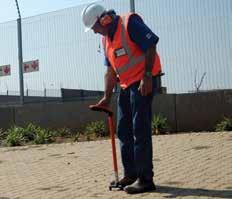
caved in during a period of particularly heavy rainfall. The collapse of the concrete slab was unexpected and needed an urgent intervention to prevent further weakening of the overall spillway structure and its potential collapse.
Full credit is due to a number of officials of the Ekurhuleni Roads and Stormwater Department, such as Alice Chauque and Philip Nice, supported by Ekurhuleni Disaster and Emergency Management Services, for their quick reaction and the ensuing mobilisation of a joint operations committee (JOC) to coordinate and oversee the action plan to deal with the emergency. Ekurhuleni Municipality was strongly supported by officials and experts from the DWS, DWS Gauteng Region, DWS Construction, the Gauteng Department of Agriculture and Rural Development, and Rand Water, to name a few.

Cover story
ORSCO deployed the LMX 200 Sensors & Software radar for the GPR survey Radar is very accurate and an excellent way to ‘X-ray’ structures Non-destructive pipe scanning Leak detection CCTV crawler (non-destructive)
Key ServiceS
ORSCO provides numerous key services, which include:
• Live, under-pressure condition assessment of water and effluent pipes (pressurised and gravity fed). These include trunk mains, distribution networks and reticulation
• GPR surveying of utility location and mapping of all underground infrastructure
• Scanning of concrete structures
• Mapping of shallow bedrock, locating voids, etc.
• CCTV/robotic crawler inspection of all type of pipelines
• Leak detection on municipal, industrial, commercial and residential networks
• Training on and hiring of scanning equipment

Sandbags were immediately installed to divert and channel the force of the water around the damaged area on the spillway. Siphon suction pumps were then installed to reduce the dam level and keep the spillway clear for damage assessment and the ensuing remedial interventions. In Phase I, the exposed gap was repaired as part of the emergency repair. The Phase I work to the spillway was completed in February 2019 to the satisfaction of all authorities concerned.
Ground-penetrating radar investigation
Henriette Anderson, as a team member of consulting engineering firm Delta Built Environment Consultants, was appointed as the APP to carry out the condition assessment and optimum repair methodology forming the second and final phase of the works. To ensure a high degree of accuracy, Benoni-based specialist subcontractor ORSCO was appointed to complete a full survey investigation of the spillway and stilling basin using GPR (ground-penetrating radar) technology
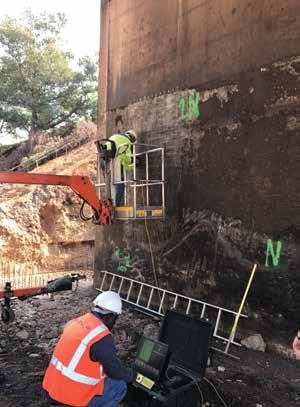
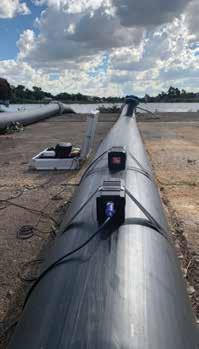
Ultrasonic flow logger measuring syphonic flow draining the dam

to map potential shallow voids underneath the concrete slabs covering the earth-fill spillway and flaws in the concrete slabs covering the spillway and stilling basin.
“Radar is very accurate and an excellent way to ‘X-ray’ structures, as well as to detect underground services such as water and sewer pipelines,” explains Darek Leskiewicz, senior consultant: GPR at ORSCO, a 6 CE CIDB contractor. “As a non-destructive methodology, it minimises the need for open-cut or core drilling during investigation and facility condition assessments, which also lowers overall project costs.”
The basic principle of GPR is the transmission of a short electromagnetic pulse, with a specified frequency, into the ground and the recording of reflected energy as a function of time, amplitude and phase. The reflected energy is recorded as a pattern on radar grams displayed in real time.
The recorded data can then be processed and analysed off-site using specialised software to produce 3D subsurface maps.
A series of GPR grids and depth slices were collected during the survey, which were divided into three sections, namely the top of the spillway, the slope of the spillway, and the stilling basin. These slices were captured at progressive depths of up to 5 m. The results from each stage were combined to create one super grid for easier data processing and interpretation.
The client will be able to use this data to pinpoint where further testing is required. This might include selective core drilling to confirm the extent of identified anomalies. That will then confirm the extent and cost of the engineering interventions required.
“The primary concern is to ensure the safety and structural integrity of the dam and the safety of those downstream,” explains Anderson.
Ground-penetrating radar used for utility location to update as-built drawings
Thanks to GPR, Ekurhuleni Municipality will have a high degree of certainly about the repairs needed in Phase II, which should significantly shorten the construction time to fully repair the erosion damage to the Middle Dam spillway. It will also enable a more costeffective approach for extending the life of this structure, rather than demolishing it completely and reconstructing.
“Worldwide, GPR has certainly revolutionised the way municipal engineers inspect and maintain a wide range of infrastructure services. As in Middle Dam’s case, it has certainly proved to be an invaluable tool,” adds Leskiewicz.
The Middle Lake Dam emergency situation and the repairs that had to be undertaken taught the Ekurhuleni Roads and Stormwater Department officials invaluable lessons (both on a technical and corporate governance level), which would not have been possible had it not been for the assistance of professionals and officials from other departments within the city, as well as departments from other spheres of government. The Roads and Stormwater Department wishes to acknowledge each and every person that contributed (whether minorly or majorly) to finding solutions to fixing the Middle Lake Dam wall and to everyone who put their trust in the department to deal with the matter.

087 160 0310 im@orsco.co.za www.orsco.co.za
C over story
IMIESA June 2019 7

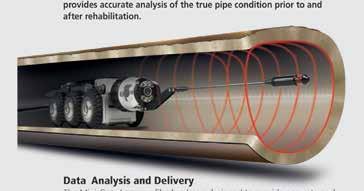

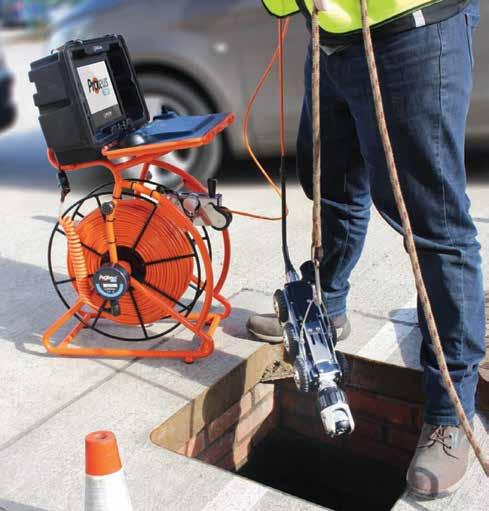













INFRASTRUCTURE NEWS FROM AROUND THE CONTINENT
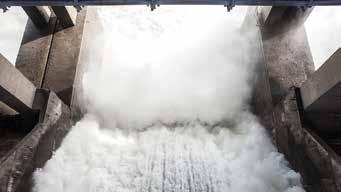
ethioPia
building an iPP framework
In an effort to support the roll-out of a sustainable procurement framework for independent power producers (IPPs) in Ethiopia, the Sustainable Energy Fund for Africa (SEFA) has approved a US$995 000 (R14.44 million) grant.
Ethiopia has vast but untapped renewable energy potential. The SEFA grant will be used to strengthen the government’s capacity to undertake bankability and technical analyses, including feasibility assessments of projects in the hydro priority pipeline. It also provides for environmental and social impact assessments, resettlement action plans, and preparation of bidding documents for hydro projects.
The Kenya Affordable Housing Finance Project (KAHFP) has acquired the loan to support the establishment and operationalisation of the Kenya Mortgage Refinance Corporation (KMRC).
The KMRC is a largely privatesector-owned and non-deposittaking financial institution under the supervision of the Central Bank of Kenya. Its goal is to drive affordability of mortgages by providing more long-term funding to financial institutions.

According to Felipe Jaramillo, country director: Kenya, World Bank, urban housing currently remains unaffordable for most Kenyans due to the cost of financing, the short loan tenures, and the high cost of properties.
Ethiopia is seeking private investment into hydropower projects
within the mortgage gap and low-cost categories, and represent 95% of the formally employed population.
Investment into affordable housing will also have a strong economic multiplier effect and could facilitate 132 000 new jobs, in addition to supporting improved health and education outcomes.
leSotho
improving water supply
US$78 million (R1.13 billion) in financing from the International Development Association is set to benefit up to 115 000 Basotho and businesses in the Lesotho Lowlands, under the Lesotho Lowlands Water Development Project – Phase II.
The project aims to finance activities to improve access to reliable domestic and industrial water supply services in the towns of Maputsoe and Hlotse, as well as settlements and villages along the transmission pipeline route.

the delivery of measurable operational improvements facilitated by change management support. These improvements include: improving the quality of its technical and financial data to facilitate decisionmaking and delivering on technical and financial performance against annual targets set by the Lesotho Electricity and Water Authority.

MozaMbique
expanding sanitation services
Roughly 200 000 Mozambicans will benefit from increased access to sanitation services thanks to a US$115 million (R1.67 billion) grant from the World Bank.
The funding will be used to provide infrastructure expansion, support institutional and capacity developments, and offer technical assistance to the cities of Maputo, Beira, Nampula, Tete and Quelimane.
This is expected to encourage private investments into hydropower projects through Ethiopia’s Renewable Energy Programme.
Kenya
Making housing affordable
The World Bank recently approved a US$250 million (R3.6 billion) International Bank for Reconstruction and Development loan to enhance access to affordable housing finance for Kenyans who are unable to access long-term housing finance.
The KAHFP support will target households that are classified by the Kenyan government to fall
The monies will also assist in improving the technical and financial performance of Lesotho’s Water and Sewage Company, for better sanitation infrastructure and services. This will be achieved by incentivising
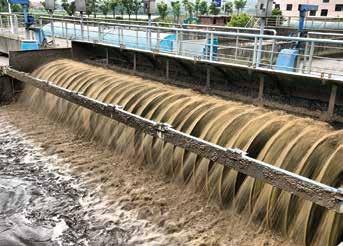
Projects include the rehabilitation end expansion of the Infulene Wastewater Treatment Plant in Maputo, as well as on-site sanitation facilities for the peri-urban residents of Quelimane and Tete. In Quelimane and Tete, sewer networks will be rehabilitated and expanded, new wastewater treatment plants constructed, and stormwater drains installed.
Currently, only 1 in 10 households has access to sanitation services, and one in three to safe water in Mozambique. These projects are expected to help alleviate pressure on already precarious sanitation infrastructure and services.
Mozambique is embarking on projects to expand its sanitation infrastructure
IMIESA June 2019 9
Two decades of excellence

A visionary leader in its field, Nyeleti Consulting celebrates its 20th birthday in 2019. iMieSa speaks to executive director Pine Pienaar about the company’s successes and future ambitions.
What sets Nyeleti apart from the competition?
PP Nyeleti is a black-owned consulting engineering firm with expertise in most civil engineering fields, specifically structural, water and transportation engineering.
Over the past 20 years, we’ve had the privilege to be involved in a number of flagship projects within South Africa, which have greatly refined our capabilities.
These include involvement in the design and construction of stadiums for the 2010 FIFA World Cup, the Gauteng Freeway Improvement Project, Gautrain, balance-of-plant and auxiliary buildings for Eskom’s Medupi and Kusile power stations, and the design of elements of the well-known Msikaba and Mtentu N2 Wild Coast bridges. We are grateful to clients and lead consultants who afforded us these opportunities.
We have also had the opportunity to design and supervise numerous projects
within the urban and rural infrastructure sphere.
These projects include road infrastructure development, the implementation of local public transport systems, and the development of water reticulation and sewerage systems.
World-class project execution is at the core of our business – and this all depends on people. Skills development, mentorship, the allocation of project responsibility, company ownership and management, succession planning, staff retention and wellness are all internal priorities. This investment in human resources has made us the success we are today.
Our slogan is ‘Engineered to excel’ and our name, Nyeleti, means ‘star’. This symbol reflects our commitment to excellence.
What does the future hold for the consulting profession?

The challenges currently being experienced within this sector are well known. Poor GDP growth, an increase in public sector debt, and increased social needs have resulted in a drastic decrease in the funding available for infrastructure development. However, over the longer term, we know that infrastructure provision and operation are essential for the economic wellbeing of the country and the development of its people. The consulting engineering profession has a huge role to play, so we’re optimistic about the future of the profession.
How have past milestone projects shaped the company?
We consider milestone projects to be important for a number of reasons. These projects are generally technically challenging, which hones the abilities of our


designers and, in some cases, construction supervisors.
Milestone projects also contribute to the company’s wellbeing, in that engineering staff generally like to be associated with these projects. In this way, these projects contribute towards staff motivation and retention. Perhaps most important is the marketing value of these projects, assisting the company with being more visible within the industry and demonstrating its capabilities.
Which projects are you currently working on?
We are pleased and grateful to have a healthy order book in this tough economic climate. An exciting project we were recently appointed for, in joint venture with Bigen African and GIBB, is the design and supervision of the Mokolo Crocodile Water Augmentation Project, Phase 2, also referred to as
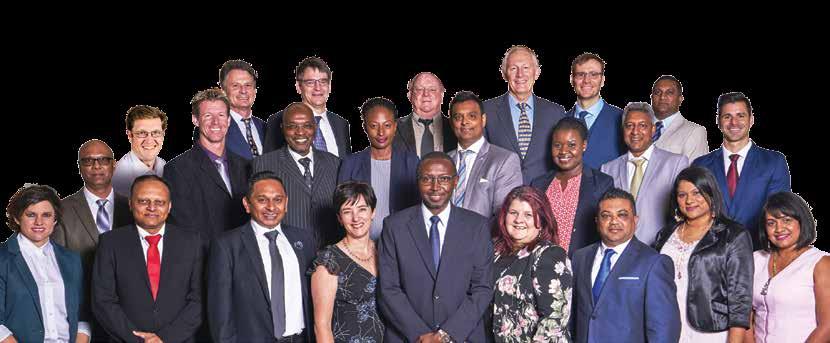
Hot s eat 10 IMIESA June 2019
Pine Pienaar, executive director, Nyeleti Consulting
Nyeleti management team

of water to the Lephalale region in Limpopo.
The project is being implemented in support of one of the strategic integration projects (SIPs) forming part of government’s National Infrastructure Plan, namely SIP 1. SIP 1 aims to unlock the economic potential of the northern mineral belt located in the Waterberg area.
Another interesting project in the water field is the Hammanskraal bulk and distribution network in Tshwane, currently in the construction phase. The project includes a bulk supply steel pipeline, 800 mm in diameter and 5.2 km long, serving Hammanskraal Ext 1, Temba and adjacent townships. The project also includes an outfall sewer, consisting of a 3.4 km long, 600 mm diameter concrete pipe. Water and sewer services are being provided to 2 770 stands, as well as toilet top structures. In the roads field, Nyeleti is responsible for the design and construction supervision of various national road projects for Sanral, including portions of the N2 and N3 in KwaZulu-Natal and the N8 ring road in Bloemfontein.
The upgrading of the Watt Interchange in Johannesburg for the JDA is a prominent project with interesting challenges, while our order book also includes a number of provincial-level road rehabilitation projects.
A first for Nyeleti is the appointment as independent engineer on the Bakwena N1-N4 Toll concession project. Here, we are working in joint venture with a newly established black-female-owned company, Merchelle’s Collective.

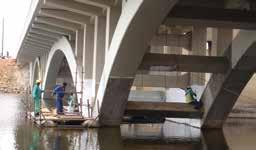
Traffic engineering and impact studies also form part of our bread-and-butter work. Although we do not currently have an active public transport project, we have been intimately involved in this field over the years. We treasure this involvement, understanding the importance of public transport in addressing the mobility needs of our population.
The work of our Forensic Investigation Unit typically consists of shorter-duration investigations into the condition of concrete infrastructure such as chimneys and silos, and the determination of structural characteristics, such as the level of provision of rebar, slab thickness or concrete properties.
Does the future plan include BOOT projects?
South Africa and the SADC region are seeing collaboration between public and private entities in the delivery of infrastructure. We are also seeing more country-tocountry project funding initiatives in countries such as Mozambique and Zambia. Continental funding institutes are coming on board to assist in delivering energy, roads and water infrastructure.
Going forward, Nyeleti would like to become more involved in BOOT or PPP projects. Our focus is to familiarise ourselves with the typical requirements and align ourselves with strategic partners active in the field.
How is technology changing engineering?
We have a history of embracing technology and our vision is to continue to do so.
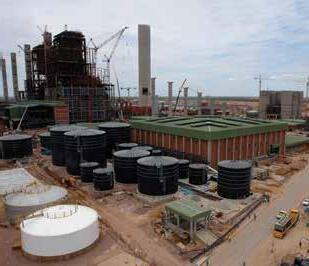
New technologies becoming essential to the profession include the exponential growth in the computational strength of computers, digitisation, geolocation, tracking and spatial technology, building information modelling, 5D design (where time and cost parameters are integrated into the 3D design model), AI, virtual reality, realtime monitoring of variables, 3D printing, drone technology, and many others.
Is the cross-border market still attractive?
Working in the SADC region is very much part of our growth strategy. Nyeleti’s approach is to focus on two or three countries. Our primary focus is Mozambique, where we have a local presence and have been successful in winning work. Nyeleti is currently busy with a 50 km water supply pipeline to Pemba, a coastal city with 200 000 inhabitants. The capital of Cabo Delgado Province, Pemba is experiencing high growth due to the development of offshore gas fields in the region.
How critical is SA’s infrastructure maintenance backlog?
In our view, the infrastructure maintenance backlog is a huge threat to efficient service delivery. As engineers, we are very aware of the effects of inadequate maintenance. Be it roads or bridges, water networks or structures, inadequate maintenance leads to a loss of functionality, a reduction in lifespan, and poses safety risks to users and communities. As a
country, we still have a long way to go to realise and understand the importance of maintenance, the implications of neglecting maintenance, and what needs to be done to address it.
What’s the vision for the next 20 years?
Nyeleti’s vision for the next two decades is built around our people and our values. We will continue to attract and retain the best talent available, ensuring that succession planning is in place for our future leaders. We have an excellent team of young engineers, both male and female. Our strategy has always been to focus on larger-scale projects that put our skills to the test; however, no project has ever been too small for Nyeleti, and we will continue to take up each and every challenge that comes our way.
In order to survive into the future, we know that we need to be at the forefront of technological developments, while identifying new fields of expertise and services that we can offer our clients. Forensic engineering investigations are a prime example – a business that we believe will grow from strength to strength over the next decade. We operate in a free market environment, so we need to offer the best service at a competitive price.

www.nyeleti.co.za
IMIESA June 2019 11 Hot s eat
Smart cities are green cities
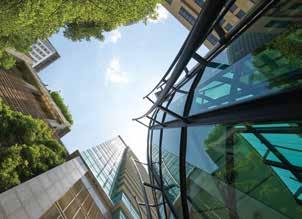
The definition of a smart city differs across sources; however, one thing is clear: all smart city initiatives should add up to a sustainable, resilient environment.
Cities are facing an increasing number of challenges, ranging from population growth and urbanisation, to declining natural resources, pollution and climate change. The world’s urban environments are becoming increasingly vulnerable and at risk, as a result.
According to Arup’s Cities Alive: rethinking green infrastructure report, a fundamental shift is needed in the design approach for urban environments, in which nature becomes a key driver. Rather than being an optional add-on, ‘greening’ must become a fundamental part of the solution.
Promoting green infrastructure
Green infrastructure is considered among the most effective tools in managing environmental risks and climate change. According to the report, green
Environmental
Improved visual amenity
Enhanced urban microclimate
Improved air quality
Reduced flood risk
Better water quality
Improved biodiversity
Reduced ambient noise
Reduced atmospheric CO2
infrastructure comprises a number of components within city environments, including open spaces, natural areas, urban woodland and parks, green streets, squares and public realm, sustainable drainage systems, rivers and waterways, cycleways and pedestrian routes, and smaller-scale interventions such as green roofs, walls and facades.
By adopting a green infrastructure approach, cities can not only become healthier and more attractive but, over time, develop into a resilient ecosystem capable of generating a substantial range of social, environmental and economic benefits, while also protecting against climate change.
“A green-infrastructure-led design approach has the potential to unlock complex interactions between, say, development, housing, flood management, food production and
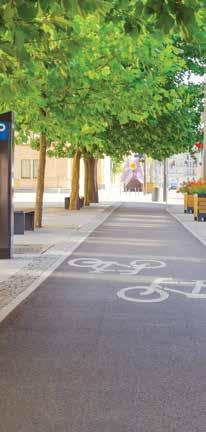
biodiversity. By adopting a multifunctional design approach, more dynamic, integrated and forward-thinking solutions can be realised, which can also generate multiple secondary benefits,” states the report.
The benefits can be seen across all sectors of society, ranging from local authorities, to residents, developers, business, retailers and tourists (see Table 1).
Down to practicalities
To see a real difference, green infrastructure should be considered from the outset of any urban project or strategy. Rather than attracting piecemeal investment, it should not be seen as an independent driver for development, but as a solution to a range of issues.
To more consistently deliver this, Cities Alive identifies the following key aspects:
Economic benefits
Increased property prices
Increased land values
Faster property sales
Inward investment encouraged
Reduced energy costs via microclimate
Regulation
Improved chances of gaining planning permission
Lower healthcare costs
Social benefits
Physical activity encouraged
Improved childhood development
Improved mental health
Faster hospital recovery rates
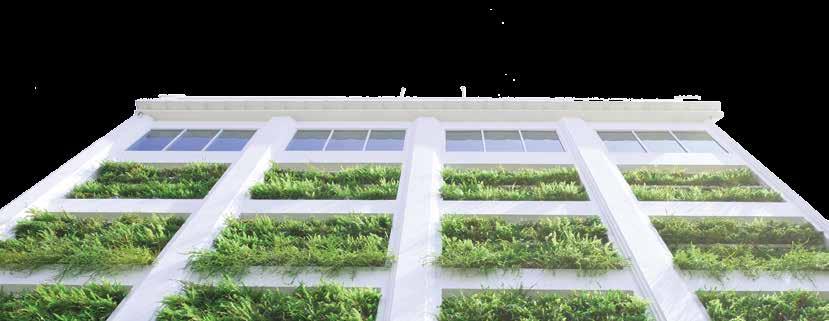
Improved mental health
Improved workplace productivity
Increased social cohesion
Reduction in crime
s ustainability | S M a RT CITIES
Table 1 Benefits of green infrastructure (Source: Cities Alive: rethinking green infrastructure, Arup)
benefits
1
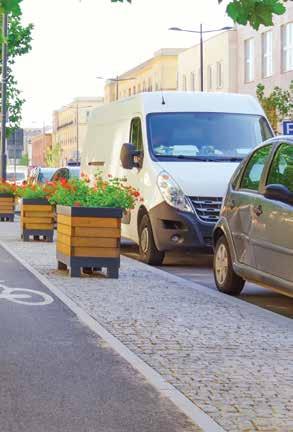
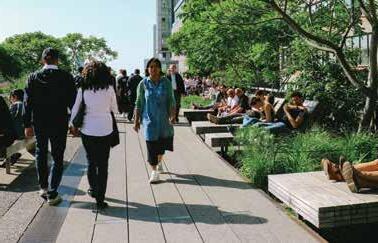
Vision – all delivery should be underpinned by and contribute to a large-scale strategic vision that identifies the assets, opportunities, risks and vulnerabilities.
2
Collaboration – green infrastructure is increasingly being seen as a concept that unites a range of disciplines and interests, and facilitates collaborative working. In the context of green infrastructure, competing priorities can often complement each other.
3
evidence – preparation of a green infrastructure framework should be underpinned by evidence to ensure that interventions are appropriate to their context. Evidence is particularly important
to understand the value of a city’s natural resources to enable future planning for enhancement potential.
4
tools – planning plays a vital role in the delivery of projects, and will be triggered in many interventions involving new and existing development.
5
Management – management and maintenance of green infrastructure should always be a key consideration from the outset of a project. This ensures longevity and secures the full potential of interventions.
6
Funding – traditionally, local authorities provided funding for the delivery, management and coordination of green infrastructure. Increasingly, this type

of funding is more difficult to secure, leading to new, creative and innovative ways for funding and the use of available resources. Considering funding for maintenance and management from the outset will help deliver long-term benefits. Cost reduction and the recognition of the value of existing assets are also important. Most importantly, political champions are needed to promote a vision in which green infrastructure adds to the quality of a city and differentiates its offer by attracting investment. Green infrastructure and its subsequent maintenance must become integral to individual projects, and must always be linked into the wider vision and framework of the city.
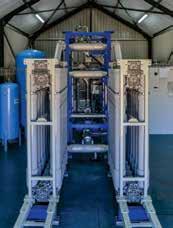
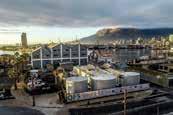



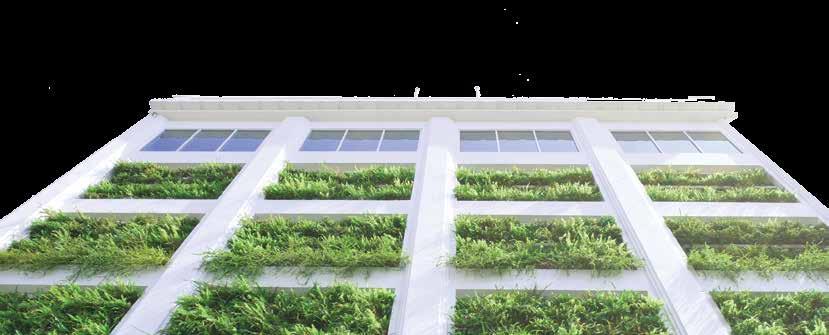
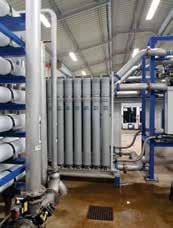 IMIESA June 2019 13
IMIESA June 2019 13
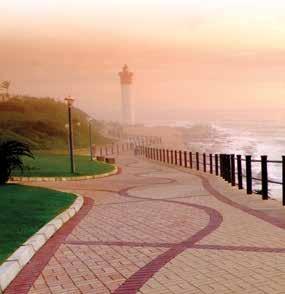
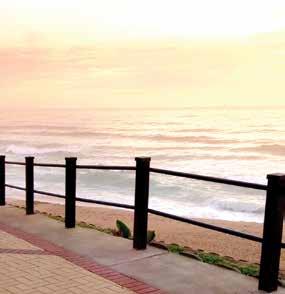
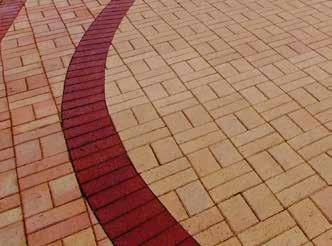
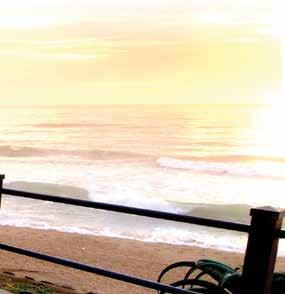

PERFECT PAVING FOR GOOD
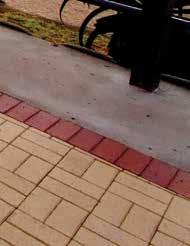
Clay pavers o er a stylish, timeless appeal with impressive sustainability credentials. And they aren’t just good looking and good for the environment - they are also low maintenance and tough enough to cope with high levels of loading for life.
Ceramic clay pavers won’t fade in corrosive industrial or coastal environments and the textured nish remains safely slip-resistant in wet or frosty conditions.
Go to www.claybrick.org to learn more about this sustainable construction material


CLAYBRICK.ORG FOECIOVEHT T H E CLAYBRICKINDUSTRY STYLE SUSTAIN SAVE SECURE environment-friendly This Switch Africa Green Project is co-funded by the European Union This project is co-funded by the European Union Promoting Inclusive Sustainable Practices in the South African Clay Brick Sector
Photograph courtesy of Corobrik
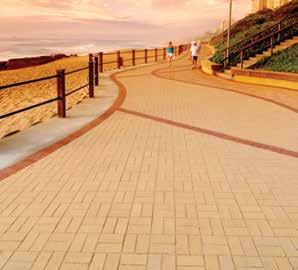


Clay pavers promote mobility
Clay pavers have been used in streets, sidewalks, paths and plazas for hundreds of years due to their durability, long-lasting colour, small scale, and ability to blend in. They also create smooth riding surfaces for wheeled users.
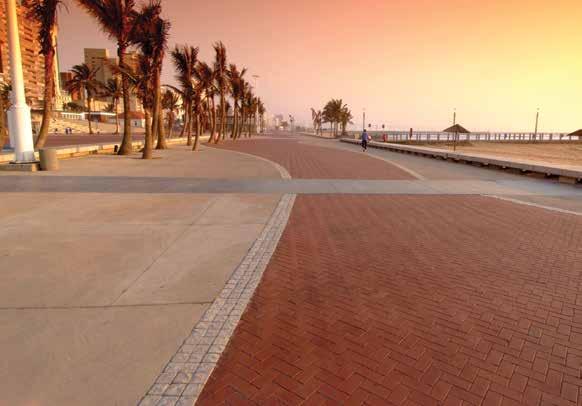
Accessibility is particularly important for people with limited mobility, whether they are in wheelchairs or using crutches or walking aids, as well as those with poor vision. It is also important that municipal infrastructure makes provision for the free movement of people in general, e.g. mothers pushing prams, workers handling trolleys, and cyclists and runners making use of designated paths. Clay segmental pavers excel in all these areas while also providing major aesthetic appeal.
“Pavements using clay segmental pavers behave differently from monolithic concrete slabs,” explains Mariana Lamont, executive director, Clay Brick Association of South Africa (CBA). “It is often assumed that large slabs are superior to clay segmental pavements because they have fewer joints.
“However, vibration measurements conclude that the narrow joints in clay segmental pavements result in less severe vibrations than control joints in concrete slabs. More joints mean smaller incremental changes between pavers. Segmental pavers are also easier to repair than poured concrete, resulting in simpler and less costly maintenance,” adds Lamont. Many clay pavers have chamfers (bevels) on their top edges. Some clay pavers also have lugs (spacers) on their sides to create uniform joint widths. The main purpose of chamfers is to reduce chipping on pavers and avoid direct contact between the top edges of adjacent pavers. Chamfers also create an interesting visual pattern and may help channel surface water run-off.
It is important to select pavers that have top surfaces and edges that are planar. Pavers with
RIGHT A section of the Green Point precinct in Cape Town surfaced with clay pavers. The design makes provision for two mature trees abOVe A roadway section along Durban’s beachfront promenade, designed using a classic herringbone pattern abOVe leFT A walkway in uMhlanga, KwaZulu-Natal, demonstrates the aesthetic appeal of clay segmental pavers
chamfers less than 6 mm wide allow the front wheel of a wheelchair (126 mm in diameter or larger) to span the distance between the top surfaces of the pavers without creating undue stress on the user. Pavers with larger chamfers may cause discomfort.
Where applied, a 90-degree herringbone pattern is preferred over a 45-degree pattern. This is because this 90-degree pattern will maintain safe levels of vibration, even with 6 mm chamfered pavers.
A running bond pattern is recommended where the longitudinal joints are aligned with the direction of travel.
Slip resistance
Clay pavers commonly have slightly roughened surfaces, which provide slip resistance without detrimentally affecting accessibility. Pavers that are heavily textured may not be suitable due to the increase in vibration for wheeled users.
Surfaces with higher coefficients of friction and slip resistance are desirable – static slip resistance values of 0.6 on horizontal surfaces and 0.8 on ramps are recommended.
Maintenance
Paving constructed with a sand bed layer is easier and cheaper to maintain. Assemblies with mortar joints will require more maintenance
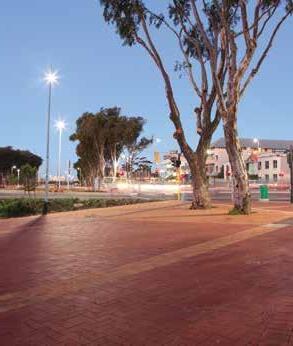
due to the mortar having a shorter lifespan than the pavers. Since the base affects the stability of the pavement, it must be strong enough to resist occasional overloading and saturation. Differences in elevation of the top surfaces of adjacent pavers should be kept to a minimum through careful design and installation, and should be maintained as part of a regular maintenance programme. Changes in level can result from heaving or settling of the pavement base and more frequently occur at features that penetrate the paver layer, such as metal manhole covers. Trees roots are a common problem, so root barriers are recommended: these force the roots to grow down rather than spreading underneath the pavement. They also strengthen the tree by causing the roots to extend deeper into the soil. It is essential to inspect and maintain paving on a regular basis. This includes, when necessary, refilling sand in the joints in sand-set brick paving assemblies. Surfaces should be regularly cleared of loose sand and stone chips. Removing mould, moss and algae, which might make the surface slippery, is also a routine maintenance requirement. In all other respects, if correctly installed and maintained, a clay segmental paving system will remain in place for decades without any movement.
For further information and technical tips, download a free copy of the CBA’s Clay Paving Guide: www.claybrick.org/paving-guide

IMIESA June 2019 15 s ustainability | Bu I l DIN g Sy STEMS
(Photographs: Corobrik)






Secure your stand now and have the opportunity to:
• present your company, products and services to a target audience
• gain industry insight and meet potential partners, suppliers and clients
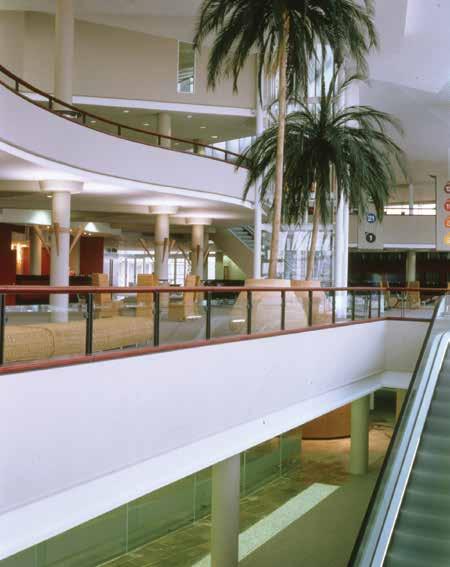
• interact with key decision-makers and industry peers


Sponsor a unique aspect of the conference and enjoy great benefits such as:
• free exhibition stands
• complimentary delegate registrations
• brand representation at the event, promotion of your company in the conference proceedings magazine and online
• free entry for guests at the social evening and much more.
EXHIBITORS BOOK your stand NOW
IMESA ORGANISER THE INSTITUTE OF MUNICIPAL ENGINEERING OF SOUTHERN AFRICA (IMESA) TEL: 031 266 3263 DEBBIE OR MELANIE CONFERENCE ENDORSED BY DURBAN INTERNATIONAL CONVENTION CENTRE 83RD IMESA CONFERENCE 02-04 October 2019 SIGN UP FOR A SPONSORSHIP NOW t +27 (031)266 3263 e conference@imesa.org.za conference.imesa.org.za Book online now
Driving building sustainability
In a first for South Africa, a new ecobrick has been manufactured mostly from previously unrecyclable material, and could enable zero waste in the luxury vinyl tile flooring space.
Evalution Flooring has embarked on the first phase of a sustainability project that will slash its carbon footprint by recycling luxury vinyl tile (LVT) offcuts and pull-ups into ecobricks, pavers and potentially other reusable products.
Until now, there had not been a way to recycle LVT due to the many layers that make up the product; however, as an LVT supplier, Evalution Flooring sought a way to recycle the products it sells and has teamed up with Recycle 4 Africa Waste Management (R4AWM) to recycle LVT offcuts and pull-ups.
“The first brick has been made completely out of recycled waste, including plastic that can’t currently be recycled and would have landed up in landfill,” says Eva Kaiser, founder, Evalution Flooring.
“Unlike other ecobricks, no sand or cement has been added. The brick has been tested and was found to have no leaching and no emissions. It also has a compressive strength of 15 MPa – higher than the average 5.2 MPa of concrete bricks. Plus, it is resistant to fire and rodent activity. The product will soon be tested officially by the National Home Builders Registration Council to obtain certification for use in the building industry,” she continues.
Sustainable building materials
This latest move by Evalution Flooring builds on its existing efforts to ensure sustainability. “Our Amtico Spacia, Amtico Spacia Acoustic and Amtico First received GreenTag Certification in
April 2018, followed by the mFlor range, which was certified in February 2019,” says Kaiser.

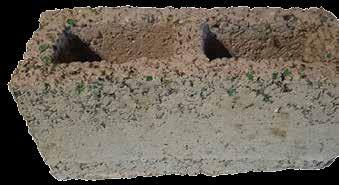
GreenTag Certification involves the entire supply chain – from the ingredients to the final product – including all sustainable practices throughout the production process.
“We only import from the Amtico and mFlor LVT factories, who are constantly making efforts to improve sustainability in their production processes. The GreenTag Certification shows that they are already well in line with what is achievable, and we will continue to work to ensure that our offcuts and pull-ups do not end up at landfill,” says Kaiser.
“Over the past 11 years, Green Building Council South Africa has been on a sustainability journey to advance the transformation of the South African built environment and construction sectors, and it is encouraging to mark this Green Star rating for internal finishes with Evalution Flooring,” says Grahame Cruickshanks, managing executive: Market Engagement, Green Building Council South Africa.
Creating a market for LVT recycling
Evalution Flooring is currently in the process of costing the establishment of a recycling facility and is working with contractors to ensure that all LVT pull-ups and offcuts are kept and returned for recycling.

“There’s plenty of LVT all around South Africa and we are currently working on how to logistically get all this material to a central point without adding to the carbon footprint. We are also exploring how to finance this massive project. While we might not be able to supply the market with ecoblocks just yet, the most important thing is that there is now a solution for directing LVT away from landfill,” explains Kaiser.
She believes that if this kind of recycling can be achieved on a national basis, the potential to produce ecobricks is huge. Although the cost per brick is still being calculated, Kaiser says it will likely be around the same price as cement building bricks.
“It is important to look after our planet in every possible way. All sectors of the building industry, including architects and clients, should be a part of ensuring that waste is minimised on a site. If everyone starts playing their role, I truly think that our ecobricks will become a reality much sooner and less waste will end up at landfill.”

s ustainability | Bu I l DIN g Sy STEMS
This new ecobrick is manufactured entirely from previously unrecyclable luxury vinyl tile
The only GreenTag Certified vinyl in South Africa. Amtico & mFlor Wood, Stone and Abstract Look LVT in stock Tel: 021 557 0599 Email: vinyl@evalution.co.za www.evalution.co.za
IMIESA June 2019 17
Bridging the gap in steel

A number of factors need to be considered when deciding on whether to build a bridge from steel or concrete. Project costs and maintenance are two key elements.
Steel offers numerous advantages, including quick construction in the field, the ability to prefabricate sections, predictable material properties, the lower weight of steel compared to that of concrete, and the fact that any structural damage is readily accessible for inspection.
“Contemporary bridge designers have the choice of steel or concrete for their construction material. However, these days, bridges are often not constructed exclusively of concrete or exclusively of steel, an example being the steel-beam and concrete-deck bridges we see today,” explains Amanuel Gebremeskel, technical director, Southern African Institute of Steel Construction (SAISC).
“The design of a bridge greatly affects its initial cost; the more efficient the design, the lower the cost. A further design consideration is the bridge’s purpose – that is, whether it will be carrying pedestrians, motor vehicles or railway rolling stock,” Gebremeskel explains.
The advantage of steel’s lower weight translates into lower erection costs, since the bridge sections can be handled using lighter construction equipment. If designed soundly, the lighter weight of the steel bridge will also allow for lighter foundations. Generally, it is easier to make spans continuous for both live and dead loads, and to develop composite action with steel designs rather than with concrete ones.
“However, the major advantage in the construction of steel bridges is that they are considerably faster to complete, with fewer logistical challenges. Where a bridge is being constructed over a busy highway, for example, disruption to traffic is far less. With steel construction, the need for time-consuming and elaborate formwork is also eliminated. If necessary, steel sections can be prefabricated off-site and then bolted and welded together to complete the final structure,” he comments.
Steel used in the construction of the Thelle Mogoerane Hospital bridge allows for an aesthetically pleasing structure
In terms of maintenance, decks are historically the most vulnerable part of the bridge. To replace a concrete bridge deck requires the removal of the entire section at one time, whereas steel bridge decks can be replaced one lane at a time, allowing for uninterrupted – albeit reduced – traffic flow.
Where bridges cross other infrastructure or geographical features such as a deep ravine or river (particularly in Africa with the often rugged terrain), steel has the advantage that the section of the completed bridge can be shallower than its concrete counterpart.
Environmental factors
“Over and above these considerations –not just locally, but globally – environmental
18 IMIESA June 2019
r oads & b ridges
considerations are also an important factor in the use of steel,” he adds.
In this respect, the raw material used to construct bridges today is often scrap steel. In a white paper, the American National Steel Bridge Alliance states that new steel bridge construction in the US consumes about 350 000 t of scrap metal annually. And, when a steel bridge has reached its allotted lifespan, the raw material can be recycled.
When bridges have to be constructed in environmentally sensitive areas, the fact that steel spans can be longer than their concrete counterparts minimises the environmental impact, as fewer piers are needed to support the bridge.
In addition, high-performance ‘weathering’ steels offer greater weather resistance and feature toughness and weldability at affordable prices. “This technology is readily available in South Africa,” Gebremeskel points out.
Advances in fabrication
forms, both internationally and locally. For example, tubular steel is now widely used and known for its aesthetic appeal, light weight and superior strength.
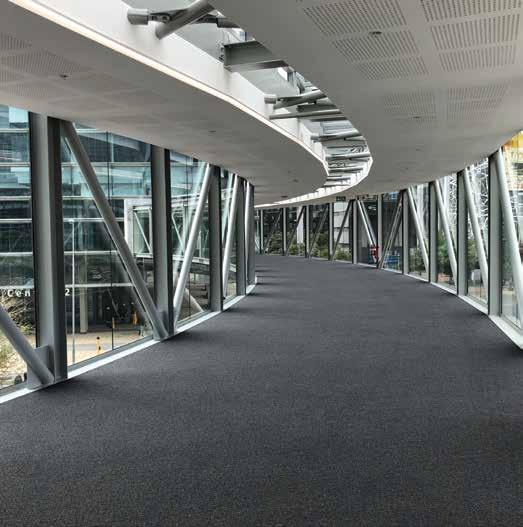
Furthermore, with the advent of laser fabrication, steel tubing can be processed very quickly into interlocking bridge components, thereby improving the strength, speed and efficiency of welding –resulting in stronger and more aesthetically appealing structures,” he says.
The choice of whether to build a steel or concrete bridge is also dictated to some extent by which region of the world the
economic benefits, the use of steel as a construction medium for bridges also offers the more lasting appeal of design excellence,” he continues.
“If one thinks of the internationally renowned San Francisco Golden Gate Bridge, Millennium Bridge in London or the Sydney Harbour Bridge, one has excellent examples of structures that are of immense practical use and yet at the same time are highly visually pleasing examples of superb engineering design.
“As with many other bridges around the world, the element that made these enduring and iconic structures possible was the versatility and excellence of steel,” Gebremeskel concludes.
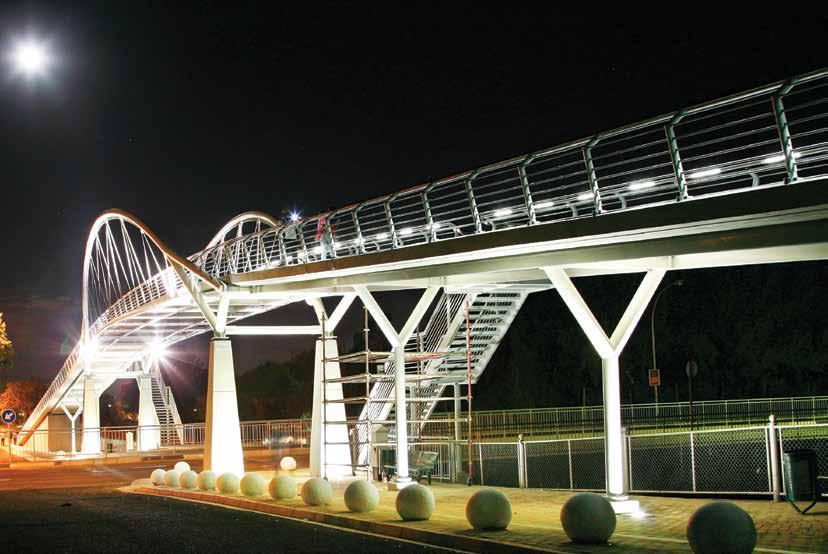
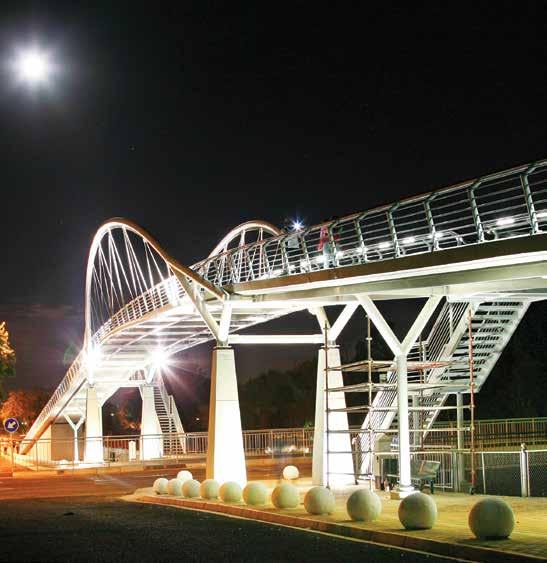
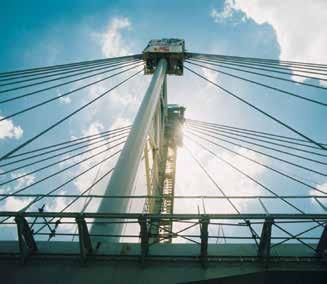
r oads & b ridges
The Markgraaff pedestrian bridge in Bloemfontein is visible confirmation that steel can be used to create a unique and innovative structure
The Nelson Mandela Bridge in Johannesburg is a tribute in steel to our iconic leader
This elegant sky bridge is one of the entrants in this year’s SAISC Steel Awards
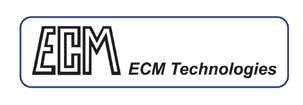
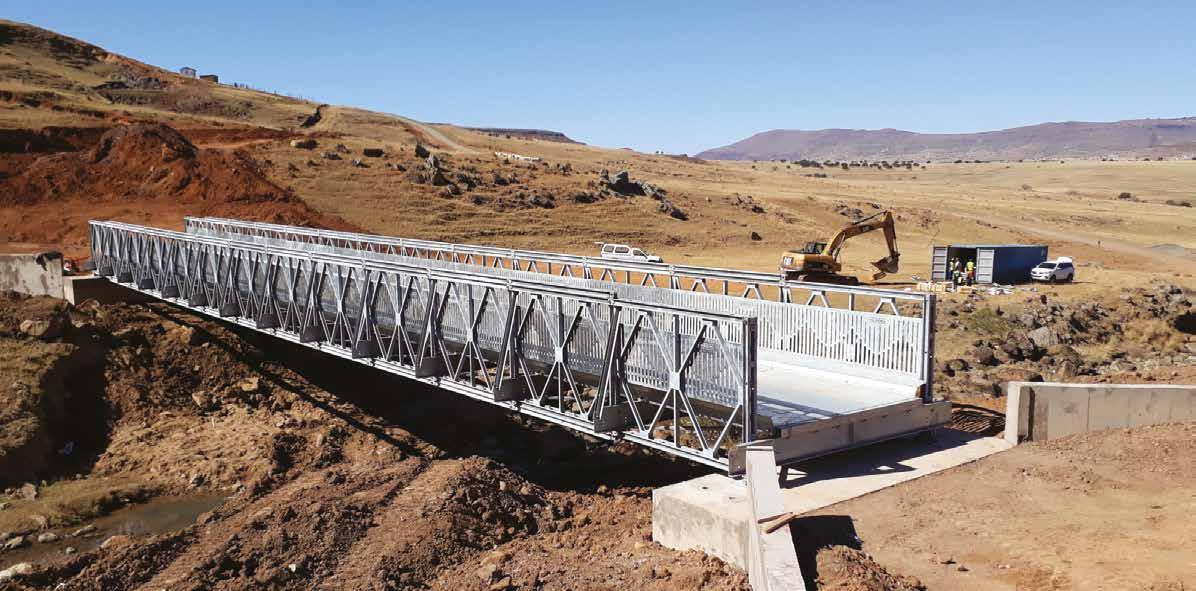
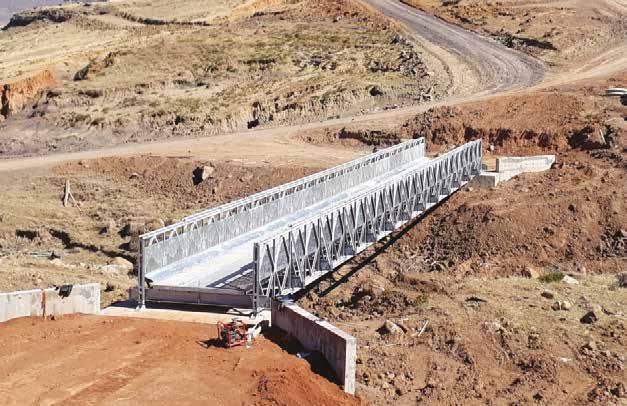
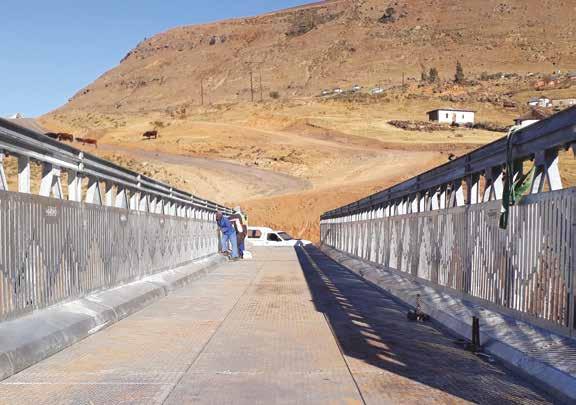
Enabling safer, faster, more efficient rural access in South Africa To see how we can enhance your project, please contact: Tel: +27 (0) 12 329 4116 Fax: +27 (0) 12 329 4120 Email: sales@ecmtech.co.za 18 Eighteenth Street, Hazelwood, Pretoria, Gauteng, South Africa www.ecmtech.co.za www.mabeybridge.com
Modular to enable rapid installation and minimise on-site works
Pre-engineered to shorten project delivery
Full-scale tested to ensure product safety and durability
Hot-dip galvanised to minimise through-life maintenance Cost-effective vs traditional concrete to ensure investment payback
Simple to transport and store for future use
Sustainable to protect the environment
Easily configurable for heavy vehicle access in partnership with Permanent and temporary steel bridging solutions for vehicle and pedestrian applications
Helping municipalities to do more with less
Local municipalities in South Africa are operating under extreme pressure. Resources are limited and there is a drive to achieve greater efficiencies –to do more with less. The result is that municipalities are forced to focus on localised projects, around the immediate towns, which they can manage, monitor, resource and maintain most efficiently at a minimum cost.
Rural projects are less tangible; they are difficult to manage and carry high risk, dependent not only on the reliability of contractors and the availability of skilled labour, but also on changeable weather conditions and challenging remote terrain. For people living in rural areas, the resulting lack of investment in rural infrastructure compromises access to hospitals, schools and basic amenities, impedes social mobility and constrains economic growth.
The good news is that help is at hand; We have been working closely with local communities for over 50 years, and have seen, first-hand, the societal and economic benefits delivered by the installation of critical infrastructure in rural locations. We know what resources municipalities have available, we understand their challenges, and so, by default, we are well-placed to be able to provide them with the tools to deliver rural infrastructure quickly, safely and efficiently… helping them to do more with less.
One such project was a recent bridging project in Ngqakaqheni village, in the Eastern Cape of South Africa. Situated at the foothill of a large mountain range with a river surrounding it, a single access road was the only access route in and out of the village. Local economic activities relied heavily on road transport and during rainy season the village could be cut off for up to two weeks at a time. To overcome this, the local municipality, Mhlontlo, looked to construct a bridge crossing the river to enable safe access throughout the year. The village’s remote location
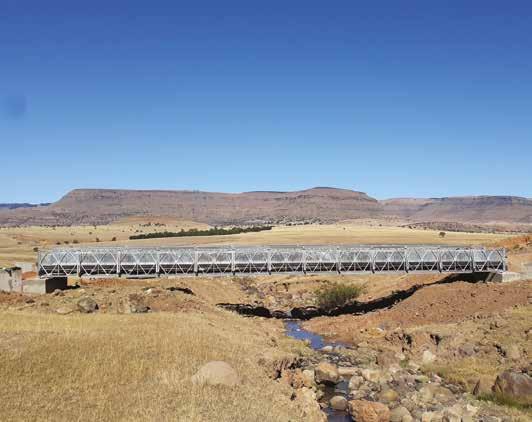
meant that it would be very difficult to use a concrete bridging solution, which would require the use of heavy-duty construction equipment, which adds logistical challenge and time-dependent mixing and curing requirements on site. Mhlontlo Municipality turned to Mabey Bridge and South Africa representatives, ECM Technologies, for an alternative solution.
A Compact 200™, Mabey Bridge’s most popular modular steel bridging solution, was chosen as the ideal solution for the project. The core focus of Mabey Bridge’s C200 design is to simplify construction methods and construction costs on site, by minimizing the requirement for heavy and costly plant and equipment, making it possible to use unskilled labour effectively and sustainably. The C200 can service both pedestrian as well as vehicular traffic and can span clear gaps of up to 60 metres without the need for any intermediate supports. Designed with safety at the forefront, the C200 can also safely carry, in standard configuration, loads of 41 tons over the 60 metre gap, enabling access for heavier delivery vehicles to service start-up businesses and small enterprises in rural communities. Furthermore, Mabey Bridge’s steel structures are all hot-dip galvanised to ensure a long and low maintenance service life.
On the Mhlonto project, the single lane 40 metre long Compact 200™ was constructed in 7 days by a local contractor with a local work force, overseen by a Mabey Bridge Site Advisor, and delivered in partnership with ECM Technologies. Now providing reliable, safe, access all year round for the rural community of Mhlonto, the project illustrates how simple, modular, off-the-shelf bridging solutions can offer significant savings in design, transport, resource, logistics and construction and also demonstrates how ease of construction and the use of unskilled labour, and minimum plant and equipment, can reduce on-site costs and minimise risk.
If you have a project like this, please get in touch. It would be our pleasure to help deliver peace of mind on each and every project you work on. Let us help you do more, with less.
IMESA 2019
We’re extremely proud of our work in South Africa. We have reduced the cost of rural bridges – so it’s possible for a higher number to be supplied and maintained – and we have reduced construction times so the benefits can be felt more quickly.
To celebrate this ongoing mission to develop critical infrastructure and connect rural communities across the region, we will be working with our South African partners, ECM Technologies, to demonstrate our expertise at this year’s IMESA event.
Visit Mabey Bridge and ECM at Stand 38 & 51 at IMESA to find out more.
Ngqakaqheni village bridging project
Bridging rural routes
The new bridge over the Mankgatle River is one of two large structures along the route
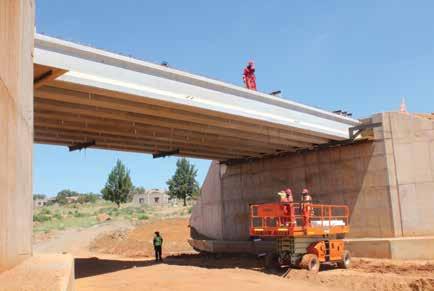
The flexibility
of
precast is well demonstrated on a modified bridge design that ties into a new road layout in Limpopo.
The Roads Agency Limpopo (RAL) is forging ahead with the construction of a new road that will connect three villages in the mainly rural Sekhukhune District Municipality to two provincial routes. Lonerock Construction is the main contractor, with works scheduled for completion in September 2019.
Since the original engineering design was completed more than eight years ago, it needed to be updated to suit current conditions.
“Road construction was delayed by RAL due to limited financing and other pressing responsibilities,” explains Joseph Myoya,
Ubona Engineers’ resident engineer on-site. “The villages have since expanded, with many properties now located within the originally planned route. The road, therefore, had to be extensively realigned to avoid having to relocate more than 200 affected properties. Our approach resulted in significant cost savings.”
The original design of the Mankgatle River Bridge was modified to meet the new and higher road realignment. This meant that substantially more reinforcing steel was required for the taller concrete abutments.
Additional precast concrete elements were also needed to build the larger 20 m long and 11.5 m wide superstructure,

Eight precast concrete beams and 126 precast concrete deck planks were manufactured and installed by CoreCivils
which stands at a height of 6 m above the riverbed.
Alternative foundation approach
The redesign of the bridge foundations also had to accommodate the terrain, which is overlain by rocks and large boulders. A decision was taken to anchor the foundations of the bases of the abutments into the large boulders, as opposed to removing them by drilling and blasting.
“Mass concrete was cast over the boulders and we then drilled through them to insert the dowels. This approach provided some cost savings for our client, considering that up to 45 000 m³ of rock had to be removed by drilling and blasting during the earthworks stages of road construction,” says Myoya.
The eight precast concrete beams and 126 deck planks were manufactured and installed by CoreCivils, the precast concrete bridge beam and parapet arm of CoreSlab.

r oads & b ridges
Reinstating a vital port connection
Studies recently completed by JG Afrika, a leading South African firm of consulting engineers, have informed the design of the rehabilitation of a strategic road that connects Tin Can Island Port to major commercial centres in Lagos State, Nigeria.
The existing access road from Tin Can Island and the sixlane expressway that connects Apapa Wharf to Oworonshoki was built as early as the 1970s, and has since fallen into a serious state of disrepair.
In addition to causing severe congestion and unsafe travel conditions, this has negatively impacted efficiencies at the port and had a knock-on effect on businesses in the area.
The rehabilitation of the road network, as part of a public-private partnership, was first mooted by AG Dangote Construction, a subsidiary of local cement entity Dangote Industries, and the proposal was favourably received by the Federal Ministry of Power Works and Housing.
JG Afrika proposed a continuously reinforced concrete pavement (CRCP) design to better cope with the growing number of heavy commercial vehicles travelling along the route. The design is similar to the technology deployed in the construction of South Africa’s Ben Schoeman Highway linking Johannesburg and Pretoria.
This design replaced the initial suggestion of using a conventional jointed concrete pavement. This would ultimately have developed slab tilting and stepping on the extremely soft subgrade material
encountered along sections of the existing road from Apapa to Oworonshoki.
In-depth pavement evaluation
Led by Dr Emile Horak, a foremost pavement specialist, JG Afrika was appointed to undertake the pavement evaluation in 2018. These critical insights have been incorporated into the final rehabilitation design by Yolas Consulting, a Nigerian engineering consultancy working on behalf of AG Dangote Construction.
A detailed assessment of the condition of the road pavements and a geotechnical investigation of the material used in the existing road were undertaken as part of the project. In addition, JG Afrika undertook an extensive investigation of all available construction materials to build the road and structures.
The studies identified high deflection on the road as a result of a very weak pavement structure, while very poor materials were also used in the construction of the existing road, especially for the foundation layers.
Testing undertaken on asphaltic concrete samples showed that all of the properties met the specification requirements and that the grading of the aggregates was within the specification envelope for wearing course. However, unsuitable material was identified
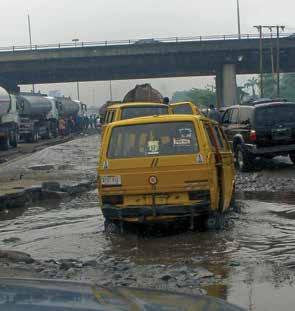
Catastrophic pavement failure due to unacceptable moisture conditions, combined with overloading
(Photograph: Looking for good in Lagos, 2011)
in the sub-base and sub-grade layers from samples that were collected at various locations along the road.
According to the study, it will be possible to source sufficient filling material from all of the borrow pit areas that were investigated, while suitable crushed rock aggregate for the base course can be obtained from the rock outcrops observed along LagosIbadan road.
The engineers also found the available aggregate, water and river sand to be of a suitable quality for the construction works. Should there be insufficient river sand, they have recommended supplementing supply with quarry dust.
JG Afrika also noted that adequate provision be made in the detail design report for drainage and sub-drainage improvement, especially in swampy areas, in addition to the need to reinstate the shoulder of the entire road.
Horak says the concrete pavement design expertise of Ane Cromhout, pavement engineer with the JG Afrika team, formed the basis of the recommendations to use CRCP. These recommendations made by JG Afrika were well received by the contractor and work is expected to commence imminently on the rehabilitation of this critical road infrastructure.
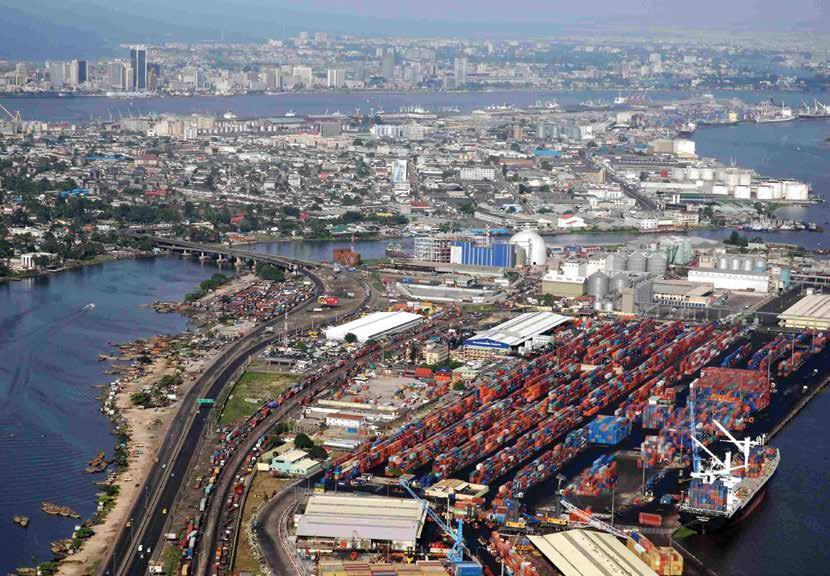
r oads & b ridges
Port of Lagos, Apapa: the largest container terminal in Nigeria
IMIESA June 2019 23
(Photo credit: Global Construction Review, 2017)
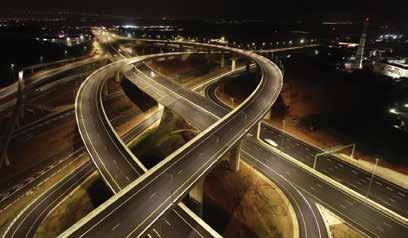
Within South Africa, close to 90% of the population has access to electricity; while in North Africa, Algeria, Egypt and Libya have virtually 100% coverage, according to World Bank data.
In-between, the percentages steadily drop. Within SADC, for example, Zambia and Zimbabwe are at around 28% and 32%, respectively, and Mozambique at approximately 21%. Botswana is the next highest after South Africa, with some 56% receiving electrical power.
Across the continent, there are a number of initiatives in progress to effect positive change. A recent example is the approval of the Regional Off-Grid Electrification Project for West Africa. This includes US$150 million (R2.2 billion) in the form of credit and grants from the International Development Association and a $74.7 million
Lighting the way

(R1.09 billion) contingent recovery grant from the Clean Technology Fund. This will help the West African Development Bank and the Ecowas Centre for Renewable Energy and Energy Efficiency expand off-grid access to electricity for populations in 19 countries. These countries include Burkina Faso, Cameroon, Ghana, Nigeria and Sierra Leone.
The project is expected to benefit about 1.7 million people currently living without an electricity connection or with unreliable supply, as well as businesses and public institutions that will use modern standalone solar systems to improve their living standards and economic activities.
EEDSM initiative
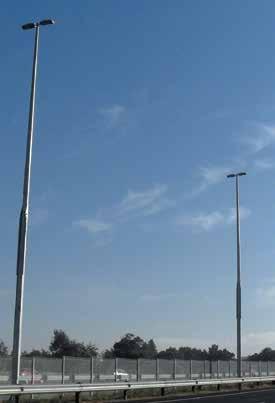



In South Africa, a key initiative aimed at promoting sustainability is the Energy Efficiency Demand Side Management (EEDSM) programme managed by the Department of Energy (DoE). The end goal is to help qualifying municipalities lower their energy footprints. They need to submit a proposal to have their business case approved for funding.
EEDSM grants support the planning and adoption of energyefficient technologies ranging from traffic and street lighting to HVAC and lighting in buildings, and interventions at purification plants. The estimated electricity saving potential for traffic lights is up to 80%; for street lighting, between 40% to 70%; for office buildings, 20% to 30%; and 15% to 25% for pumps used for water provision and treatment.
Municipalities interested in the EEDSM programme have to respond to the requests for proposal issued by the DoE at the beginning of October each year. The DoE evaluates these proposals based on their energy savings potential, cost and payback period.
EEDSM best practice lighting examples include traffic light installations for Swartland Municipality in the Western Cape, resulting in a forecasted saving of approximately 29 MWh annually over a 6.5-year payback period. In place of 50 W lightbulbs, 9 kW LED lightbulbs were installed at 50 robots.
Another example saw Nelson Mandela Bay Metropolitan Municipality install 400 W LED lightbulbs on 360 high masts in place of conventional lightbulbs, at a cost of around R8.8 million. The projected savings on installation were 1 050 MWh annually, over a payback period of 6.9 years.
Nationally, public lighting, alongside electrification, remains a top priority for municipalities, particularly in informal areas. Going forward, and alongside LED technologies, the installation of solar systems will be part of the mix in providing immediate solutions that don’t place further demands on the grid.
24 IMIESA June 2019 STRUCTA TECHNOLOGY is part of the STRUCTA GROUP of Companies T: 0861 STRUCT (787828) F: 016 362 3608 E: masts@structatech.co.za Meyerton, Gauteng www.structatech.co.za Specialists in the design, supply and installation of lighting support structures Full mast kits, “ready to erect” including mast, electricals, lights and pre-cast foundations can be supplied LEADERS IN LIGHTING MAST TECHNOLOGY Street light poles Midbow lighting masts Abamax hydraulically liftable masts Standard high masts Stadium masts Street light poles Midbow lighting masts Standard high masts Stadium masts Hydromax hydraulically liftable masts Structa Technology is a Level 1 BBBEE Contributor Public lighting








Steel Pipe for Water, Petrochemicals, Gas, Construction and Mining

Hall Longmore ranks amongst the most reputable pipe manufacturers in the world. The company’s world-class manufacturing facilities produce large-bore welded steel pipes for a variety of applications.

























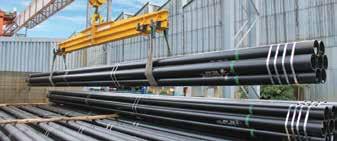





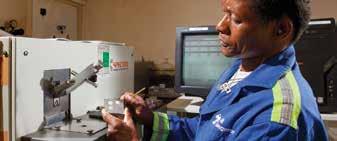








+27 11 874 7300 info@hall-longmore.co.za www.hall-longmore.co.za Established in 1924 Electric Resistance Welded Steel Pipe Oil Country Tubular Goods Helical Submerged Arc Welded Pipe International Specification Coatings and Linings International Quality Standards
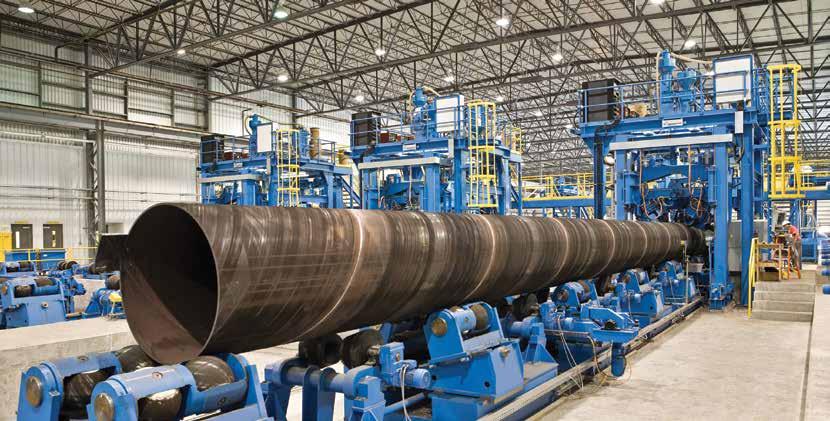

Spiral welded pipes ideal for municipal works
For many decades, the most critical water projects in South Africa have either used spiral welded steel pipes or have had steel pipe as a construction option, all locally manufactured and purpose-designed for each application. by Keitumetse Moumakoe*
TThe roll-out of water and sanitation civil infrastructure is a key step towards the realisation of ensuring water security and availability in our communities
he issue of water security for South Africa not only circumscribes the entire water sector, but also has far-reaching consequences across the entire economy of South Africa. In the context of the Department of Water and Sanitation’s master plan, water security touches on many facets, including identifying future water sources for our growing population, the operation and maintenance of water and sanitation infrastructure, and the proper management of our water quality. It affects the growth and development of all sectors of our economy.
The roll-out of water and sanitation civil infrastructure is a key step towards the realisation of ensuring water security and
availability in our communities. It also has a plethora of value-added opportunities addressing employment, industrialisation, manufacturing localisation and designation of materials.
Spiral welded pipe is a 100% designated product as per Treasury Designated Sector Circular No.4 of 2017/2018 and a product that is suitably applicable in municipal piping applications for the conveyance of water. It has been used extensively by many municipalities and metros in their water infrastructure projects with great success, sustainability and suitability.
Locally, we have three proudly South African companies manufacturing spirally welded, large-bore steel pipes, ranging from
Meters, Pi P es, Pu MP s & valves
26 IMIESA June 2019

Spiral welded pipe is designated because it is readily manufactured in South Africa, sufficiently meeting all local demand needs. It is in many ways superior to imported products designed to serve similar purposes
500 mm up to 3 500 mm in diameter – these are Africa Pipe Industries, Hall Longmore and LB Pipes (formerly Group Five Pipe). They have been servicing and supplying pipeline infrastructure for water projects for many years and on various notable projects. Examples of a few municipal projects are:
• TCTA – Vaal River Eastern Subsection (VRESAP) where Eskom and Sasol were key strategic end-users: 125 km water pipeline.
OD: 1 930 mm; steel grade: API X42, X52 and X65; Sintakote coating and bitumen fibre wrap.
• eThekwini Water and Sanitation: 70 km Western Aqueduct. OD: 610 mm to 1 600 mm; Sintakote coating.
• Komati Water Supply Augmentation Scheme: 70 km water pipeline.
OD: 813 mm and 1 118 mm; steel grade: API X42 and X52.
• Contermanskloof Reservoir for City of Cape Town: 2.2 km pipeline. OD: 914 mm to 1 016 mm; steel grade: API X42. Cement mortar lining; rigid polyurethane coating.
• Booysens Ext 4 for City of Tshwane: 4.9 km pipeline. OD: 800 mm to 1 100 mm; solvent-free epoxy lining; rigid polyurethane coating.
• Various pipelines for Rand Water augmentation projects, and upgrades of various diameters, mainly using X42 grade steel. Solvent-free epoxy lining; polymer modified bitumen coating.
Spiral welded pipe is designated because it is readily manufactured in South Africa, sufficiently meeting all local demand needs.
It is in many ways superior to imported products designed to serve similar purposes.
Fully engineered system
The versatility and strength of spiral welded steel pipes allow for customised performancebased designs to meet the criteria specified. Unlike other imported products that have been used by some municipalities, the type of steel can be selected to meet the specific strength and other physical/mechanical properties needed for a given application. The imported products can only be regarded as commodities, as they limit the ability of a designer to engineer to specific needs.
The ability to fully engineer a steel pipe system with a wall thickness ranging from 4.5 mm to 25 mm, to the type of integral jointing system needed, to the specific type of lining and coating (based on the nature of the soils in which it is buried and the fluid it transports), and to the inside diameter required makes it one of the most versatile products available for use in municipal applications.
The availability of spiral welded steel pipes in diameter sizes of 500 mm up to 3 500 mm makes them ideal for critical water transmission projects. And, of course, the ability to fully engineer a system results in significant cost savings.
Tensile, yield and elongation
Imported commodity products typically have a standard tensile: yield: elongation
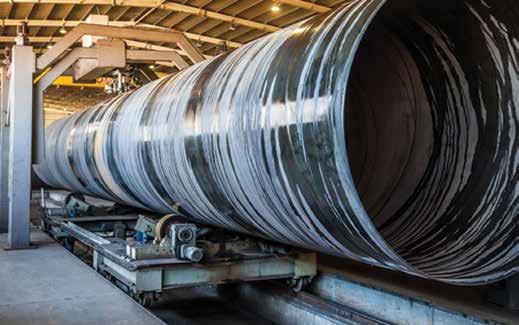
ratio that is representative of all such products used in water and sanitation applications. The ratio for steel can be adjusted as needed. For example, tensile strength can be varied from 50 ksi to 70 ksi; yield strength can be varied from 33 ksi to 55 ksi; and elongation can be varied from 18% to 30% or more.
The ability to vary the elongation of steel pipes allows it to withstand stresses and strains without fracturing under shocks from surge, water hammer, earthquakes, cave-ins, washouts, extreme temperature changes, traffic vibrations, unstable foundations, and blasting.
Corrosion control
The reason for the wide use of steel pipe is directly related to the steel pipe industry’s efforts to control the effects of corrosion when metal pipes are buried, resulting in a minimum service life of 50 to 100 years.
In order to prolong the lifespan of the pipelines, a variety of linings and coatings, which are adapted to suit South African conditions and challenges, are offered. Corrosion protection on pipelines is critical, as corrosion can reduce pipe service life drastically, makes water unfit for use, and also exposes the environment to harmful materials.
The steel pipe industry offers very effective lining and coating systems. Linings such as cement mortar significantly improve the longterm hydraulic capabilities of steel pipe by preventing internal corrosion or tuberculation. On the coatings side, both cement mortar and polyurethane are products of choice. Other dielectric coatings are also specified throughout South Africa for both water and wastewater applications.
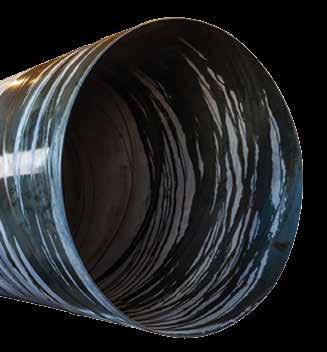
*Keitumetse Moumakoe is the executive director at the Steel Tube Export Association of South Africa.
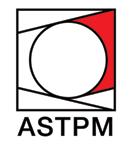
www.astpm.com
IMIESA June 2019 27
Meters, Pi P es, Pu MP s & valves
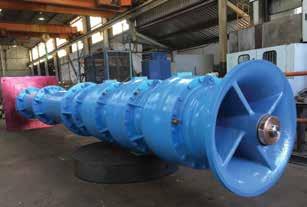
Opting for non-OEM components can be a costly business, voiding warranties and causing system failures.
Genuine parts deliver
APE Pumps and sister entity Mather+Platt have been at the forefront of pump innovation within the Southern African market for close to seven decades. Their wellestablished track record continues to be refined by the group’s research and development arm.
Sectors covered include municipalities and public utilities, energy, mining, petrochemical, as well as general industry. These are supported by leading APE Pump and Mather+Platt group brands that include Gruppo Aturia, Viking, Vanton and EIM.
“Providing a total OEM solution means our clients have the assurance that their fluid handling systems are backed by comprehensive after-sales and warranty programmes,” explains John Montgomery, general manager for APE Pumps and Mather+Platt. “That’s important to emphasise, particularly when it comes to scheduled servicing and maintenance.
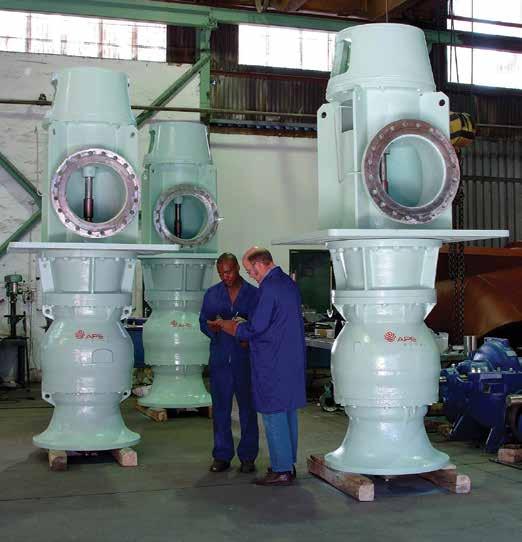
“Outside the warranty period, it remains essential for facilities owners to continue using OEM parts. However, from time-to-time we do encounter situations where clients opt for non-OEM replicated parts, or even choose the pirated part route,” he says. “That has serious implications for overall system performance, since it’s rare for replicated parts to exactly fit the original OEM tolerance specifications. The precise tolerances that need to be achieved can be as exact as one thousandth of a millimetre.”
Internal components like impellers, couplings and seals are all subjected to high pressure ratings and, depending on the application, corrosive environments. For this reason, APE Pumps and Mather+Platt group products meet exacting metallurgical standards. This ensures that premature failures do not occur – something a non-OEM component cannot guarantee.

APE Pumps and Mather+Platt conduct manufacturer-warranted repairs, and supply new OEM pumps and valves. They also offer a turnkey installation and commissioning service.
Retrofits and bespoke solutions
“An exception to the OEM rule is where retrofits are needed on older pump brands where that OEM
no longer exists. In these instances, the technical drawings are also often no longer available,” Montgomery continues. “We’ve retrofitted pumps in the past that were more than 40 years old.”
APE Pumps and Mather+Platt have the expertise to make a pattern for any application and frequently develop replacement solutions for customers. At other times, patterns are made where clients request alternations to existing APE Pumps or Mather+Platt OEM designs to achieve the right flows and pressures for their application. In the past, three individual patterns were designed for stainless steel, bronze and cast iron. APE Pumps and Mather+Platt have subsequently introduced a one-pattern format for all metallurgical compositions.
Whether it’s an off-the-shelf product, an OEM custom design, or a retrofit, all work comes with a warranty.
“Cutting costs by going the non-OEM route is certain to impact on delivery and could well result in a catastrophic failure, prime examples being on a fire pump set-up or a wastewater plant. So, speak to an expert OEM before considering the replicated route. Our operations and maintenance teams can devise a solution that keeps maintenance overheads within agreed targets to ensure that pump and business performance is never compromised,” Montgomery concludes.
28 IMIESA June 2019 Meters, Pi P es, Pu MP s & valves
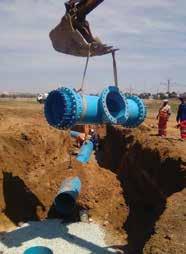
PVC-O advances

Across South Africa, Sizabantu Piping Systems is gaining ground in the high-pressure bulk water supply sector. iMieSa speaks to Greg Loock, director, Sizabantu, about the rapid acceptance of Molecor’s PVC-O technology. Sizabantu is Molecor’s official distributor in Southern Africa, which includes the TOM500 series.
What are the benefits of TOM500 PVC-O?
gl TOM500 PVC-O pipe involves the molecular orientation of normal uPVC pipe and allows for PVC pipe to now be manufactured in higher pressure classes and larger diameters. When comparing the hydraulic capacity of TOM500 PVC-O to other materials available, it is also notable that TOM500 PVC-O has substantially greater capacity at smaller diameters compared to alternative products on the market. This allows engineers to consider a smallerdiameter pipe without any compromise in overall system performance and capacity, which passes on project cost savings.
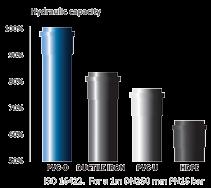

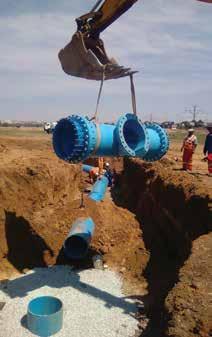
Where is TOM500 positioned in terms of the municipal market?
TOM500 PVC-O is ideally suited for bulk water pipelines where higher pressures are required. It is available in a range from 110 mm to 800 mm diameter and in pressure classes from 12 to 25 bar, so it competes directly with materials like steel and ductile iron pipe. However, unlike these materials, TOM500 PVC-O does not rely on a coating or lining for performance, but rather its molecular orientation. Nor does it require cathodic protection, as is the case with metallic pipe compositions. This means that TOM500 PVC-O costs less to install than comparable materials. Once installed, this pipe has a design life of 100 years and requires minimal maintenance.
What’s the strategy behind the TOM500 PVO-C range?
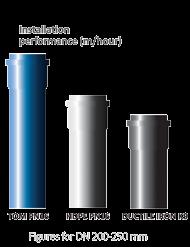
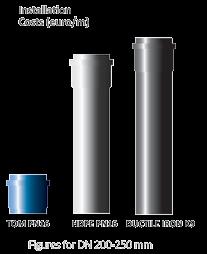
First, TOM500 PVC-O is manufactured in South Africa and is accredited by SANS. For Southern Africa, this gives water authorities quality assurance. There are no foreign specifications to adapt to, and material delivered will always be of the highest quality. Furthermore, the importation process is seamless due to the product being protected by the SADC region’s regulations – so
IMIESA June 2019 29 Meters, Pi P es, Pu MP s & valves
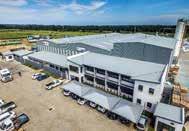
there are no import taxes. Due to the light weight of It, more local contractors can also participate in the installation of these pipelines, as no heavy equipment is required.
Where is the TOM500 range produced?
TOM500 PVC-O is manufactured locally at our state-of-the-art manufacturing plant in the in Richards Bay SEZ, KwaZulu-Natal. This plant is a joint venture between Sizabantu and Spanish OEM Molecor. Molecor is the developer of the technology and partnered with Sizabantu through a substantial investment in the factory. Through this joint venture, Molecor and


Sizabantu have introduced the latest technology available in thermoplastics to South Africa, creating new jobs and transferring world-leading skills.
What are the latest developments at the Richards Bay factory?
The initial investment in Phase I involved the commissioning of equipment, so we could commence manufacturing TOM500 PVC-O. Due to the exceptional results and increased demand for a sustainable solution for bulk and potable water pipelines, Sizabantu and Molecor are now ready for the implementation of Phase II. This will increase our capacity by around 30%.
Could you please expand on recent projects?
Sizabantu has recently supplied the following projects:
- Sibange Bulk Water, Mpumalanga: this project consisted of 4 400 m of 500 mm PN20 TOM500 PVC-O and 3 300 m of 500 mm PN16 TOM500 PVC-O.
- Driekoppies Bulk Water, Mpumalanga: here, we supplied 6 600 m of
630 mm PN16 TOM500 PVC-O.
- Nandoni Phase 2, Limpopo: this project entailed the supply of 36 000 m of 500 mm PN20 TOM500 PVC-O.
- Jouberton Bulk Water, North West: this project consisted of 7 500 m of 800 mm PN20 TOM500 PVC-O.
Since 2014, Sizabantu has supplied more than 3 800 000 m of TOM500 PVC-O throughout Southern Africa.
Can PVC-O be recycled?
TOM500 PVC-O is an environmentally friendly product that is totally recyclable in terms of the SANS 16422 specification. It also uses less energy when installed, as well as during the manufacturing process, compared to any other pipe material, making TOM500 PVC-O the conscious choice for preserving the environment.
What is the future outlook for PVC-O?
TOM500 PVC-O is currently available in diameters up to 800 mm. However, we can manufacture up to 1 200 mm in diameter at a maximum pressure of 16 bar.




NOT ALL PLASTICS ARE ALIKE














Plastics is a generic term covering a very wide array of materials and applications. It could be a simple bag to carry your groceries and needing to last one day, a colourful toy for a toddler, a bearing to enable low-friction rotation of a fast rotating shaft, an impact resistant body part on a modern car, or a large diameter pipe to carry a fluid under pressure and required to last a hundred years. Each application requires a di erent grade of polymer and obviously a vastly di erent design and manufacturing approach. High performance plastic pipes are made from very specialised polymers that were unknown half-a-century ago. It enables pressure pipe sizes with diameters more than 3 000 mm or operating pressure capabilities up to 2 500 kPa. MOST CERTAINLY ARE NOT ALL PLASTICS ALIKE!
Join the Southern African Plastic Pipe Manufacturers Association (SAPPMA) for this year’s PIPES XII CONFERENCE | 27 & 28 AUGUST 2019 ALTRON BUSINESS PARK, MIDRAND, JHB PIPES XII 27 & 28 AUG 2019 • Two days of in-depth and world-class presentations on issues relating to plastic piping, water infrastructure and engineering • International and local experts • Exhibitions and displays • Valuable networking opportunities R3500 + VAT per delegate R2600 + VAT per delegate (SAPPMA and IFPA Members) R1900 + VAT per delegate (Group bookings 5+) Sponsorship and marketing opportunities available. FOR MORE INFORMATION VISIT OR CONTACT: Admin@sappma.co.za or visit www.sappma.co.za � “A great platform for learning and interacting with my South African and international peers” - Safripol � “A high quality conference with excellent networking opportunities” - Chemsystems
Meters, Pi P es, Pu MP s & valves
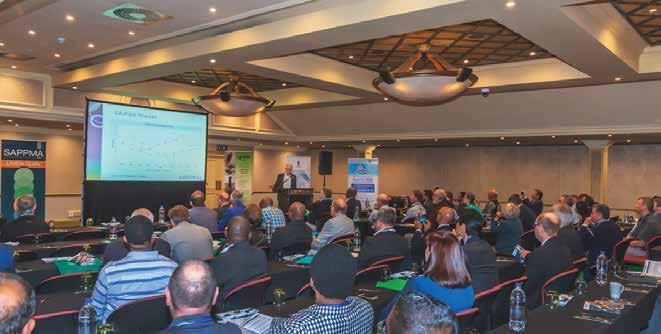
Exploring the future of plastic pipes

The countdown to PIPES XII has begun. The event promises to unveil key insights and new technologies directed at meeting current and future infrastructure roll-outs across broad sectors, which include water, sanitation, oil and gas.
The annual Southern African Plastic Pipe Manufacturers (SAPPMA) PIPES conference is a major event on the industry’s calendar, with 2019 being the 12th in the series.
PIPES XII takes place on 27 and 28 August 2019 at Altron Business Park (previously known as the Bytes Conference Centre) in Midrand, and will be attended

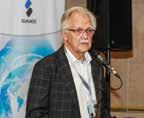


by local and international delegates. The theme for this year’s event is ‘Not all plastics are alike’.
Presenters at this year’s event have been invited to take a closer look at the quality standards that govern the manufacturing and installation of high-performance plastic pipes and pipe systems. Popular economist and political commentator Dr Roelof Botha will deliver the keynote address on the first day. Other presenters will include local and international experts such as Stefan Schiesser (Borealis), Antoine Walter (GF Piping Systems), Albert Lueghamer (Agru), Marco van Dijk (UP), George Diliyannis (Safripol), Mike Smart (Genesis Consulting), Renier Snyman (Sun Ace), Onno Fortuin (Onno Fortuin Consulting), Kirtida Bhana (Plastics|SA), Jacques van Eck (Avesco), and Alaster Goyns (PIPES cc), to name but a few.
New format
“We decided to change the format slightly this year by doing away with parallel sessions.
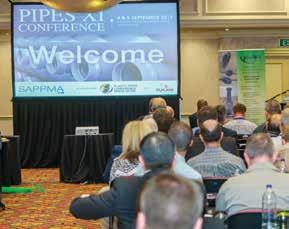
Popular economist and political commentator Dr Roelof Botha is the keynote speaker at PIPES XII
Instead, the conference will be taking place over two days and will give everybody the opportunity to attend all the sessions, while the speakers get the benefit of larger audiences and maximum exposure,” explains Jan Venter, CEO, SAPPMA.
The PIPES conferences have gained a reputation for delivering practical, yet cutting-edge information and are not-tobe-missed events for anybody involved in pipe manufacturing or installation, water infrastructure and civil engineering. The cost for attending the two days is R3 500 per delegate for non-SAPPMA and non-IFPA members; R2 600 for members; and a special discounted price of R1 900 per delegate for group bookings of five or more.
“As always, there will be ample opportunity for delegates to network, visit exhibitions and engage in lively discussions during the question and answer sessions,” says Venter.
“We are excited to announce that a number of sponsors have already confirmed they will be supporting this year’s event, including big names such as Rare Plastics, Sun Ace, Sizabantu Piping Systems and NSF International. Other sponsors and exhibitors include Swan Plastics, Safripol, Astore Keymak and Alprene Plastic Products. We look forward to announcing more sponsorships soon and to seeing a record number of delegates attend this year’s conference,” Venter concludes.
For more information about sponsorship benefits and packages or to purchase tickets to the PIPES XII conference, please email Louise Muller at admin@sappma.co.za or visit www.sappma.co.za for more information.

IMIESA June 2019 31 Meters, Pi P es, Pu MP s & valves
Key benefits
of prepaid water

Prepaid and post-paid water costs exactly the same. However, prepaid systems provide far more precise control. by Marcus thulsidas
It is common knowledge that we live in a water-stressed country, receiving an annual rainfall of around 492 mm. In addition, some 98% of South Africa’s water has already been allocated to users, leaving little surplus water to cater for a growing population and increasing demand.
Within this context, there’s a strong argument for prepaid water – like prepaid electricity – as a solution to more sustainable water consumption and management. Appreciating the advantages is an ongoing education process.
Prepaid water means that the consumer purchases water credit in the form of a prepaid water token. When entered into the user interface unit (located in the consumer’s home), the token instructs the water management device to allow a certain amount of water through the meter before closing. Consumers can track usage, load credit remotely, and decrease the possibility of bill shock due to leakages or incorrect monitoring.
A prepaid water meter can also be used to limit water flowing to a particular area.
This helps municipalities and property owners control the amount of water used at certain outputs. It also prevents wastage in lowincome households that cannot afford to pay for excess use of this basic need. These households can make payment in smaller, frequent increments. This prevents them falling into debt, which can compound in a post-paid arrangement.
The ability to access this service is completely dependent on the municipality. So, even if you’re feeling inspired to install a smart water management device to enable prepaid water, you may not be able to, based on where you live or work. That being said, most municipalities are beginning to embrace prepaid water management technology.
The implications for rental properties and body corporates are significant. Prepaid metering reduces admin to a minimum, while removing the risk and frustration of late or non-payment of water bills. This is why housing estates are swiftly moving to prepaid water, as they did with prepaid electricity. Gone are the days of splitting the entire estate’s water bill by the number of units: prepaid metering means that users pay solely for their own consumption.
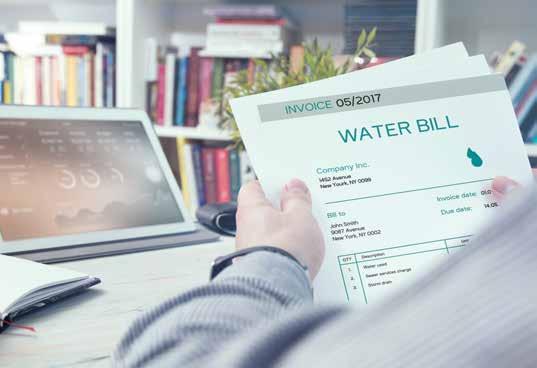
 Marcus Thulsidas, director: Business Development, Utility Systems
Marcus Thulsidas, director: Business Development, Utility Systems
Savings for municipalities
Prepaid systems are cost-effective solutions to sustainable water management since they have a low cost of acquisition; by curbing water usage, capital recovery is possible within months. The systems are also able to distribute water equally, based on free water quotas, water balancing and fluctuating demand.
Aside from their ability to alert municipalities to leaks, prepaid water meters also drastically reduce government’s admin costs. This is because municipalities don’t need to chase bad debts or budget for legal fees on unpaid accounts. Public sector cash flow is immediately improved.
Collecting data from prepaid meters is also more efficient than the manual collection required for post-paid meters. A radio link receiver can be fixed, vehicle-mounted, or carried by municipality personnel.
The bottom line is that even the simplest smart water management device can provide the tools to track and control water usage. Prepaid water meters are smart tools with the potential to revolutionise water conservation efforts and revenue management worldwide. But it’ll be a while before every South African household is able to benefit from this enormous potential.
32 IMIESA June 2019 Meters, Pi P es, Pu MP s & valves
Capacity boost for Zuikerbosch
Veolia Water Technologies South Africa has been awarded the contract to design, manufacture, supply, deliver, install, commission and put into service a new pump station in Boksburg, Ekurhuleni. Once completed, the pump station will become ‘Engine Room 3’ at the Boksburg plant. It will supplement the existing pump station’s water capacity by approximately 600 Mℓ/day, increasing the plant’s daily capacity to 1 100 Mℓ/day.
The scope of work includes all mechanical and electrical equipment and parts. Minor civil works outside the main pump station building also form part of Veolia’s project responsibilities and include concrete valve chambers and underground pipework for the cross connection pipeline, the fire water pipe network, and the domestic service water system.
The manufacturing and procurement phase, expected to take 17 months, is scheduled to begin in June 2019 and run to
A Veolia technician carries out a plant inspection
November 2020. Installation will begin in February 2021 for completion by October that year. Commissioning and operation will follow, with project conclusion expected by early January 2022.
“We will be importing specialised instrumentation and electrical equipment from Germany and the USA,” says Chris Braybrooke, GM: Marketing, Veolia Water Technologies. “This equipment pertains to specific brands not manufactured in South Africa, although they will all be sourced via local companies.” He adds that the mediumvoltage motors, pipes, valves, electrical and telecom cables will be locally produced, and will meet the stipulated minimum threshold for local production content.
All civil requirements will be subcontracted to a third party, as will various other activities, to ensure that Veolia complies with the South African government’s Preferential Procurement

Regulations 2017. Veolia will also provide the pump station’s personnel with training during the trial and operation period, expected to last four weeks, and will include operation, maintenance and asset management instruction.
Water for this pump station will be drawn from the Vaal River System, subsequent to treatment at Zuikerbosch Treatment Works.



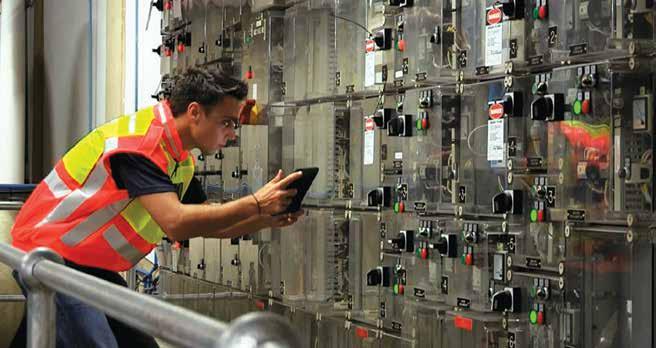

WaTER & Wa STEWaTER
June 2019 33
IMIESA
Creating a financially sustainable sector

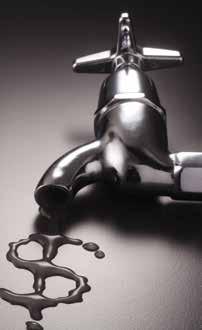
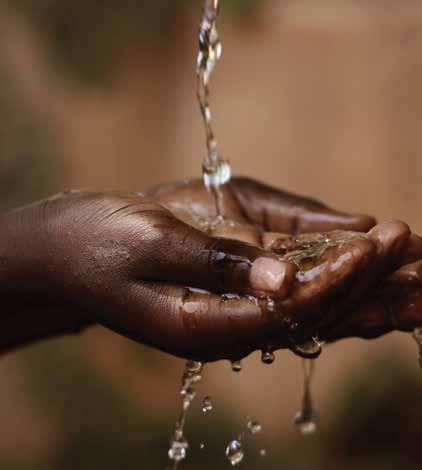
South Africa’s National Water and Sanitation Master Plan clearly states that the country’s water and sanitation sector is not currently financially sustainable.
by danielle Petterson

1
2
The local water and sanitation sector faces numerous problems, not least of which is a funding gap of R330 billion over the next 10 years. This is compounded by a municipal water debt of R13 billion, deteriorating infrastructure, declining water quality and poor municipal water governance.
A growing challenge
In the 2014 MuSSA Municpal Vulnerability Index, 47% of water services authorities (WSAs) ranked themselves as being in a critical state.
The challenges they face are threefold:
Insufficient infrastructure capacity, paired with ageing infrastructure and under-investment in operations and maintenance.
Poor governance and institutional capacity, which leads to an inability to attract and retain skilled personnel, employment of the wrong personnel, corruption and under-use of existing government grants.
3
Financial challenges as a result of poor billing practices, not ring-fencing revenues, incorrect tariffs, and poor credit ratings.
According to Alex McNamara, programme manager: Climate and Water, National Business Initiative (NBi), WSAs can achieve a virtuous water cycle in spite of these challenges, and partnerships with the private sector may offer a solution.
Investment in SA’s water sector
According to Anton Earle, director: Africa Regional Centre, Stockholm International Water Institute, the estimated
WaTER & Wa STEWaTER
34 IMIESA June 2019
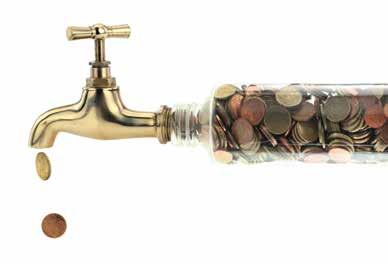
investment in South Africa’s water sector over the next 10 years is R899 billion. However, there are a number of challenges the sector faces, not least of which is an investment shortfall of 37%. Access to private sector investment, financial resources, skills and technical expertise is, therefore, needed to drive the sector forward.
Encouragingly, Earle has identified an increased use of performance-based contracting both in South Africa and Africa’s water and sanitation space. These range from full-blown public-private partnerships (PPPs) to other variations of private sector involvement that see payments tied to the achievement of targets.
However, African utilities and governments are typically concerned about entering into long-term contracts, largely for political reasons, preferring short contracts of around 10 to 15 years. Private sector service providers, on the other hand, don’t see this as long enough for the capital investment, preferring 20- to 30-year contracts.
Importantly, Earle notes a positive correlation between the contract duration and the degree of risk transferred to the private sector. Utilities can also build their social, environmental and developmental objectives into PPP agreements, in order to better achieve their targets.
However, negotiating these types of contracts requires internal capacity within WSAs. Furthermore, PPPs that are well operated are generally also well regulated, with good oversight. Where this is lacking, WSAs run the risk of suboptimal service delivery. Private sector operators also tend to favour stronger regulation, because there is a reputational risk associated with not being regulated, explains Earle. The internal
capacity of utilities is, therefore, crucial to the success of PPPs.
Viability of PPPs in SA
NBi has developed a report, entitled Water PPP opportunities in South Africa, which assesses where the main opportunities for formal water PPPs are likely to be located at both geographic and value chain levels.
A tool was developed to rank the theoretical PPP potential of 144 of South Africa’s WSAs, using demonstrated need, PPP sustainability, openness to PPPs and municipal capacity as metrics. It found that only four WSAs showed excellent PPP potential, while a further 24 have good or very good potential for PPPs. Unfortunately, the remaining 116 fell within the low or very low PPP potential band.
“PPPs are definitely a solution, but only under certain conditions where the success factors are in place,” says McNamara. This relies largely on effective WSAs, where there is sufficient procurement capacity and enough time is allowed for project preparation.
Financial feasibility is a big part of this. Earle reports that there is frequently a disconnect between the technical feasibility and financial feasibility when it comes to water projects in Africa. Often, there is very little work done on determining financial feasibility, including determining people’s capacity to pay for services and developing a business model to recover debt.
The right types of projects are also important. According to McNamara, experts consistently raised desalination, any form of water reuse, non-revenue water and wastewater treatment as the main PPP opportunities in the water value chain.
challengeS and opportunitieS in africa
• Only 3.8% of Africa’s water resources are developed
• Only 7% of the continent’s hydropower has been developed
• There is an estimated US$11 billion infrastructure investment backlog
• Water and sanitation receives only 17% of Africa’s total infrastructure investment

Strengthening capacity
For the vast majority of South Africa’s WSAs, PPPs are not theoretically viable. Unfortunately, many of these WSAs are in what McNamara refers to as ‘crisis mode’, and in need of external assistance in order to function properly. These authorities are faced with a very limited revenue base, are unable to borrow money, and make inadequate use of government grants.
In these cases, long-term external support is needed with oversight from national government and municipal councils. A revised implementation model would also allow for more effective use of government grants.
According to McNamara, the strengthening of municipal capacity, revenues and tariffs underpins much of the investment needed in the sector. This is essential for the effective use of government grants, achieving an appropriate spending balance between capex and opex, and creating opportunities to attract private sector investment and PPPs.
This should be coupled with an innovative approach to government grants. In theory, water-related grants owing to poorly capacitated WSAs could be implemented on their behalf by another organ of state. These allocated grants can then be used to attract additional funding sources through a blended finance approach. This would leverage every rand of government funding multiple times and enhance service delivery in difficult operating environments, McNamara explains.
Lastly, McNamara recommends that a pool of centralised transaction advisers be developed to proactively support municipal projects in areas with sufficient potential. This would see WSAs being guided through the process from feasibility studies onwards –not just for PPPs, but for water and sanitation projects across the value chain.
IMIESA June 2019 35 WaTER & Wa STEWaTER
WSAs Municipality type PPP sustainability score Opportunity ranking City of Johannesburg Metro 78.3 Excellent eThekwini Municipality Metro 63.3 Excellent City of Cape Town Metro 62.0 Excellent Ekurhuleni Municipality Metro 61.3 Excellent Polokwane B1 50.8 Very good Breede Valley B2 50.4 Very good Witzenberg B3 50.4 Very good Mangaung Metro 50.0 Very good
Table 1 WSAs with the highest theoretical PPP potential (Source: NBi)
Conflicting data impacts RO delivery
Correct raw water quality information is imperative for the optimum functioning of reverse osmosis (RO) plants and has a direct bearing on its design and projected operating costs. In the case of one of Cape Town’s key installations, unexpected environmental factors have come into play. by nico-ben Janse van rensburg*
As is routine for a project of this nature, research studies were completed in preparation for the construction of Cape Town’s desalination plant at the V&A Waterfront. The data supplied to Quality Filtration Systems (QFS) formed the basis for the design and commissioning of the RO system. Feeding the plant is an abstraction point constructed in the harbour, about 16 m offshore.
Based on the initial data provided, it was anticipated that the water salinity would remain reasonably constant. Preliminary data showed the water to be fairly clean following turbidity measurement.
Factors that were taken into account included the presence of oil due to shipping activity, plus seasonal algal blooms that occur naturally. To mitigate the risk of oil ingress, the abstraction intake point was constructed at a depth of about 13 m. With its lower density, most of the oil present would float near the surface, while minimal dissolved oil would reach the bottom near the intake. In turn, the overdesigned capacity of the plant would
provide sufficient buffer capacity to allow for shutdown during an algal bloom.
Initial testing
During initial testing between 8 January 2018 and 5 March 2018, it was confirmed that the oil did not pose a significant risk, especially as the RO membranes only need to last for 24 months; however, an unexpected phenomenon occurred. The salinity, measured as total dissolved solids (TDS), showed great variance.
TDS, as sampled at the extraction point and tested by AL Abbot, showed a variance between 38 710 mg/ℓ and 45 779 mg/ℓ. Past data provided in the tender document showed little variation, between 35 964 mg/ℓ and 37 744 mg/ℓ. As a consequence, there has been a significant increase in the amount of energy required to desalinate this water.
Feedwater quality
During operation of the plant, it was also discovered that frequent spikes in water turbidity were occurring.
The plant was initially designed to operate on sand filters followed by cartridge filters. The cartridge filters would require monthly replacement, while the sand filters would require a weekly backwash. The replacement frequency of the filters was based on a 95 percentile turbidity value of 3.9 NTU, with a single outlier of 7.4 NTU.
During operation from March to May 2018, it was discovered that the sand filters did not require any backwash, while the cartridge filters needed far more regular replacement. The presence of raw sewage was determined to be one of the major causes. Frequent sampling of the sea water showed E. coli counts exceeding 150 counts per 100 mℓ
Graph 1 shows the measured turbidity experienced from 28 March to 23 July 2018.
The 95 percentile during this period was 20.6 NTU, while the mean was 10.3 NTU – that was a fourfold increase in the initial turbidity forecast.
After May, and through the winter season of 2018, the turbidity became even worse. Graph 2 shows the measured turbidity during the winter period.
At first glance, and with the same statistics calculated, it would seem that the situation had improved. The 95 percentile was slightly lower, at 17.4 NTU with a mean of 8.2 NTU. There were, however, frequent spikes.
Experience showed that at levels above 15 NTU, a set of filters would become blocked within eight hours, requiring replacement. Experience also showed that the effects of a turbidity spike last beyond the point at which
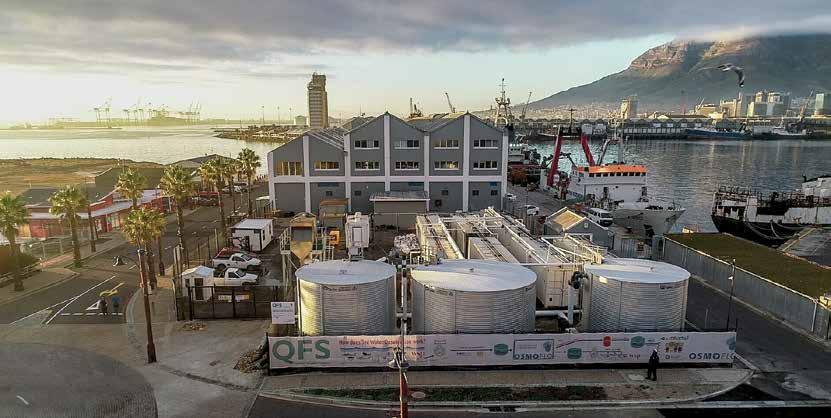
36 IMIESA June 2019 WaTER & Wa STEWaTER
GRapH 1 Feedwater turbidity from 28 March to 23 July 2018
intake turbidity drops. These frequent spikes result in an average filter replacement cycle of every eight hours, rather than every month as per the initial design.
Conclusion
The recurring pattern of turbidity spikes during rainfall periods demonstrated that the effects of stormwater and sewage run-offs into the sea are detrimental to effective RO plant operations. Such a plant cannot be operated without proper pre-treatment processes capable of handling these conditions. Although the run-offs are the direct cause of the feedwater turbidity, this is further worsened by the intentional fact that the harbour is well protected against currents and storms. The lack of sea currents means that waste is not being dispersed as fast and effectively as it would in the open ocean. Waste and faecal matter accumulate, and bacteria such as E. coli proliferate due to the relatively stagnant water in the harbour basin, which is not good news for an RO plant.
* Nico-Ben Janse van Rensburg is a process engineer at Quality Filtration Systems.
29-May-201806:00:00 02-Jun-2018 06:00:00 06-Jun-2018 06:00:00 10-Jun-2018 06:00:00 14-Jun-2018 06:00:00 20-Jun-2018 06:00:00 24-Jun-2018 06:00:00 28-Jun-2018 06:00:00 02-Jul-2018 06:00:00 06-Jul-2018 06:00:00 10-Jul-2018 06:00:00
GRapH
30-Jul-2018 06:00:00 03-Aug-201806:00:0008-Aug-201806:00:0012-Aug-201806:00:0016-Aug-201806:00:0020-Aug-201806:00:0024-Aug-201806:00:0028-Aug-201806:00:0001-Sep-201806:00:0005-Sep-201806:00:0009-Sep-201806:00:0013-Sep-201806:00:0020-Sep-201806:00:0024-Sep-201806:00:0028-Sep-201806:00:0002-Oct-201806:00:0006-Oct-201806:00:0010-Oct-201806:00:0014-Oct-201806:00:0018-Oct-201806:00:0022-Oct-201806:00:00
Date
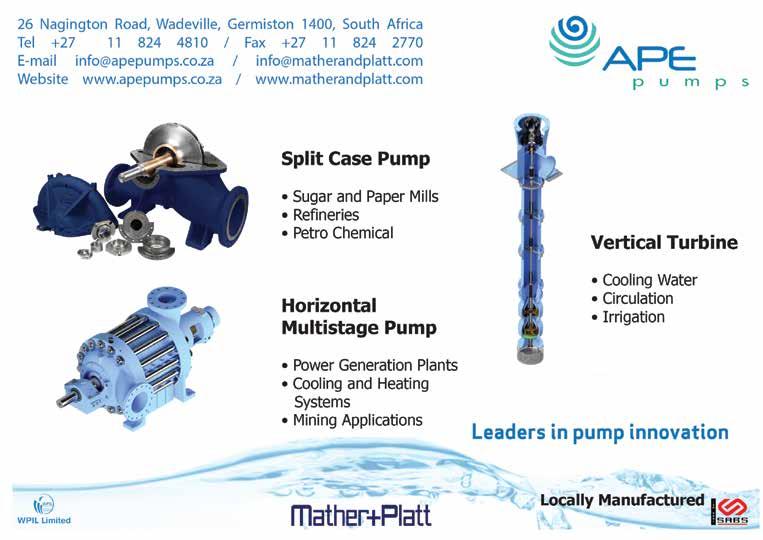
0 20 40 60 Turbidity (NTU)
Turbidity Data 95 percentile Average
14-Jul-2018 07:00:00 18-Jul-2018 07:00:00 22-Jul-2018 07:00:00 Date 0 20 40 60 Turbidity (NTU) Turbidity from 28 March to 23 July 2018 Turbidity Data 95 percentile Average WaTER & Wa STEWaTER
Turbidity from 29 July to end of October
2 Feedwater turbidity from 29 July to end October 2018

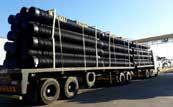

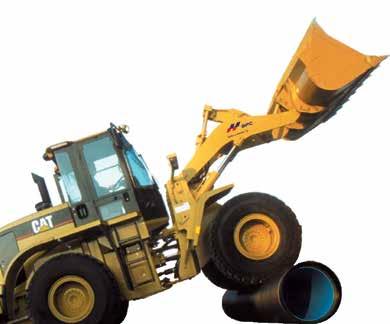
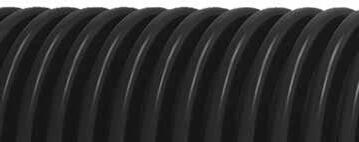

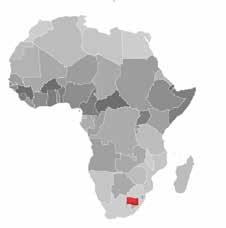
Tunnel designers prep for Phase II

The Lesotho Highlands Water Project (LHWP) is a multiphased initiative intended to provide water to Gauteng in South Africa and to generate hydro-electricity for Lesotho. The project entails harnessing the waters of the Senqu/Orange River in the Lesotho highlands, through the construction of a series of dams, for the mutual benefit of the two countries. Phase I of the project was completed in 2003 and inaugurated in 2004. Phase II is currently under way. This phase comprises the construction of the Polihali Dam, an approximately 38 km transfer tunnel to convey water from Polihali to Katse Dam, and all associated advance infrastructure.
SMEC South Africa, as a member of the Metsi a Senqu-Khubelu Consultants Joint Venture (MSKC) appointed by the Lesotho Highlands Development Authority (LHDA), is providing professional services for the design and construction supervision of the Polihali Transfer Tunnel.
Altogether, MSKC will carry out the design and construction supervision of: approximately 8.3 km of drill-andblast tunnels, including intake tunnels, access adits, connector tunnels and outlet tunnels; approximately 34 km of tunnel-boring-machine tunnels;
Katse Dam is a double-curvature concrete arch dam with a crest length of 710 m
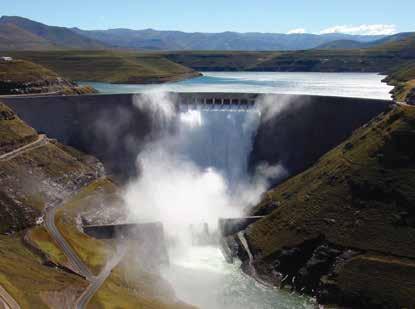
approximately 230 m of shaft sinking; a lake-tap outlet into the Katse reservoir; and all associated concrete work, access roads, site offices, storage/laydown areas, and other related surface works and infrastructure.
“Training LHDA staff to operate and maintain the tunnel is part of the skills and technology transfer element of this contract,” states Chris Viljoen, project director, SMEC South Africa. “The contract also makes provision for the training of young professionals.”
In terms of the treaty between Lesotho and South Africa, water from the LHWP is transferred via the Katse reservoir, through a transfer tunnel and delivery tunnel, to the Ash River outfall between Clarens and Bethlehem in South Africa. Water flows from the Ash River into the Liebenbergsvlei, which joins the Wilge River near Frankfort, before finally reaching the Vaal Dam.
Phase II is expected to ensure another source of reliable water supply to South Africa, meeting growing demand in particular from the Gauteng region. Once completed, the current supply rate from the LHWP to the Vaal System of 780 million m3 per annum is expected to increase to approximately 1 255 million m3 per annum.
Da MS & R ESER v OIRS
IMIESA June 2019 39
The Ash River outfall established during Phase I of the Lesotho Highlands Water Project

When
it comes to the rehabilitation and installation of water pipelines, there are a number of trenchless technologies available. However, it is crucial to understand the system in order to make the best choice for a particular pipeline.
by alaster goyns*
Although the same basic principles are used when designing pipelines, there are significant differences between the requirements of pressure and gravity systems, which need consideration when using trenchless methodologies. With pressure pipelines, the energy needed to move the water through the pipeline is provided by the head difference between the inlet and outlet. As these pipelines generally follow the ground line, they are placed as close as possible to the surface and can go uphill and downhill, provided there is sufficient pressure in the system. So long
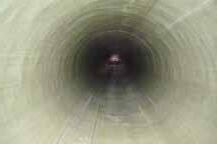

Key considerations for trenchless projects
as the pipeline diameter remains constant throughout the system, the velocity for a given discharge will also be constant. Coping with the internal pressure is the dominant structural requirement.
On the other hand, the energy needed to move water through gravity pipelines is provided by the invert gradient. Any changes in invert gradient will influence the velocity and discharge. This means that the pipeline may not follow the ground line, resulting in fill heights along its length being variable and frequently at great depths. Having sufficient strength to handle the external loads is the dominant structural requirement.
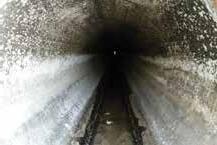

This difference in the hydraulic and structural requirements between pressure and gravity pipelines has a significant influence on any trenchless work required. Trenchless technology (TT) can be grouped into four broad categories, namely: relining; on-line replacement; new installations; and the support services such as inspections, pipe cleaning and over-pumping.
Relining
The simplest of all the lining systems is slip lining, which can be used for both pressure and gravity pipelines. It consists of pulling a long section of new pipe through
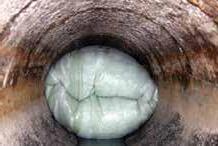
40 IMIESA June 2019
sastt t ren CH less n ews
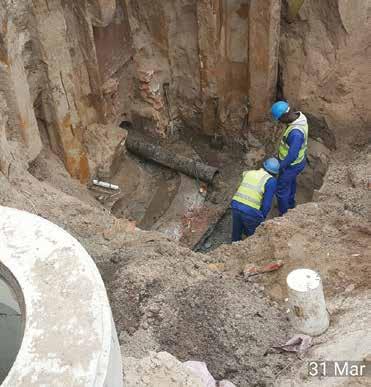
the existing pipeline, resulting in a reduction in the internal diameter, which in turn reduces the capacity and creates a void between the liner and host pipe. This system is effective if hydraulic capacity is not an issue and, in the case of gravity systems, there is no problem with the vertical alignment.











For pressure pipelines that are rehabilitated, all the primary (conveying the required quantity of water) and secondary (strength, water-tightness and durability) requirements can be adequately met by using curedin-place pipe (CIPP), fold-and-form and other close-fit lining solutions. These will cause a slight reduction in flow area, but this is countered by the smooth continuous liner with no joints, resulting in little or no reduction in flow capacity.
These close-fit lining techniques are also effective for the rehabilitation of gravity systems where the primary and secondary requirements can be met, provided there is not a problem with the invert gradient. However, if there are problems with the vertical alignment, these will act as a control on the pipeline capacity and a check needs to be done to ensure that the required hydraulic performance is not compromised.
It is important to note that rehabilitation in the form of lining or on-line replacement will follow the existing pipeline alignment and cannot be expected to rectify a problem built into the system.
On-line replacement
In South Africa’s established urban areas, much of the ageing water infrastructure has reached the end of its design life, resulting in frequent breakages. In many areas, this is exacerbated by urban densification, for which the pipelines do not have adequate capacity. Relining them addresses the secondary problems; however, it does not address the primary issue of capacity.
Replacing these services by digging trenches where there is little or no space causes significant social and business disruption, as well as pollution from construction vehicles and potential damage to other buried services. Under these conditions, on-line replacement techniques such as pipe bursting, splitting or reaming can be used – they follow the route of the old pipeline, break it and simultaneously

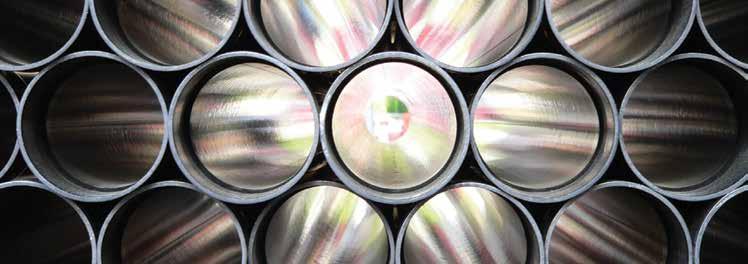







sastt t ren CH less n ews www.trenchless.co.za +27 (0)86 006 6344 info@trenchless.co.za 25 YEARS SASTT Award of Excellence 2007, 2009, 2015 & 2017 WINNER SASTT AWARD OF EXCELLENCE 2017 FOR WORLD-FIRST PIPE REAMING IN TSHWANE Pipe Bursting • Sliplining • CIPP UV Cure • CIPP Ambient Cure Ribloc Expanda • Ribloc Ribline • Ribloc Rotoloc • Pipe Reaming Horizontal Directional Drilling • Guided Rock Drilling • Bores of 1400mm Lengths up to 1000 metres • Microtunnelling • Pipe Ramming

Using TT instead of the traditional open trenching approach for the rehabilitation and installation of pipelines offers significant technical, social and environmental advantages
upsize and replace it with a new pipeline, which is generally joint-free.
A small increase in diameter makes a big difference, and doubling the diameter means an increase in capacity of 6.35 times.
Support services
Before any decisions are made about remedial work on a pipeline, its condition should be assessed. In many situations, the reported defects are symptoms of problems that are buried and may only occur at isolated sections of the pipeline. By doing an internal CCTV inspection, a visual representation along the whole pipeline is provided from which the defects can be identified and their location and extent determined.
This inspection may not, however, show the severity and cause of the problems. With certain problems – such as the corrosion of cementitious sewers, pipeline settlement or siltation – a more detailed, multisensor inspection with laser and sonar profilers should be performed.
Importantly, these inspections only assess the internal surface of the pipe and should be supplemented by excavating test pits along the pipeline to determine the pipes’ external condition.
Doing a thorough condition assessment of a pipeline includes a structural and hydraulic analysis based on its long section to identify
critical sections where hydraulic, structural and durability problems can be expected. These must then be checked against those identified by the physical inspections.
Structural, hydraulic and leakage problems may frequently be isolated to short sections of a gravity pipeline, such as in a sewer, and it may be possible to rectify them using either internal TT point repair techniques or, if necessary, repairs from the surface. That said, durability problems are seldom isolated and it is usually necessary to rehabilitate several reaches (sections from manhole to manhole) of the sewer.
New installations
When new pipelines are required in congested urban areas, or where transportation routes or waterways have to be crossed, there are several appropriate approaches. For distances over 100 m, there are two effective techniques, namely horizontal directional drilling (HDD) and microtunnelling.
HDD is very effective for long crossings (internationally up to several thousand metres) where the route has to negotiate surface features and subsurface obstacles. It is suitable for pressures pipelines, but the gradient control makes it generally unsuitable for gravity pipelines on flatter grades. Microtunnelling and other variations of pipe jacking, on the other hand, need
access shafts at about 300 m centres, but are generally very effective at maintaining accurate alignment, making them suitable for installing gravity systems.
Using TT instead of the traditional open trenching approach for the rehabilitation and installation of pipelines offers significant technical, social and environmental advantages. The amount of excavated material is usually less than 10% of that for open trench installations, and considerably less for relining and on-line replacement projects. In fact, some techniques offer zero excavated spoil. The other advantages relate to the minimum social, commercial and environmental disruption and significantly reduced air pollution as a result of fewer construction vehicles on-site.
From a technical perspective, the imposed vertical earth loading on the pipeline when using TT is significantly less because the rehabilitated or new pipeline is pulled or pushed through the soil or expanded into it. The pipeline is surrounded by soil that has already been compacted and consolidated, as distinct from being placed in a trench and then back-filled with soil that is compacted and then consolidates with time.
Because these techniques are not reliant on finding open space along a pipeline route, the restrictions on the depth of placement, and their ability to avoid foundations and other buried services, they make very effective use of the three-dimensional space below the congested surfaces of our cities. In doing so, they provide us with essential water services without disrupting our lives during their installation or rehabilitation.
*Alaster Goyns is the owner of PIPES cc.

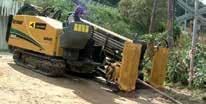
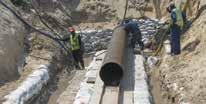

Slip Lining
include: •
•
•
• Pipe Ramming • CCTV Inspection •
• Industrial Pipe Cleaning • HDPE Welding • Deep Excavation and Shoring • Underground Service Detection • Close-fit lining: COMPACT PIPE For more information you can contact us: +27 (0)21 761 3474 F +27 (0)21 797 1151 E info@tt-innovations.co.za www.tt-innovations.co.za Trenchless Technology Specialist
Our range of services
Pipe Bursting • Horizontal Directional Drilling
Pipe Rehabilitation
Dewatering
sastt t ren CH less n ews
Moving mountains for sport


Alarge, steep hill standing in the way of expanding Somerset College’s existing sports campus meant that major earthmoving was unavoidable. Faced with exposed cut and fill slopes, the main contractor on-site, Poplar Trading, needed a cost-effective and aesthetically pleasing way to retain these embankments, which were up to 5 m high.
“We needed to create space on a massive slope for two new rugby fields, two cricket ovals and a hockey field,” explains Keon Marais of Poplar Trading. “To achieve this, we moved 80 000 m² of earth and placed 55 000 m² of drainage.”
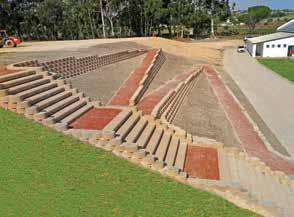
project team
Engineer:
Icos Engineering
Quantity surveyor:
QS Bureau
Main contractor: Poplar Trading
Subcontractor: Decorton Retaining Systems
Decorton Retaining Systems was called in as the expert installer for the Terraforce walls needed on-site. The scope included building a retaining wall with staircases and wheelchair ramps for student access, as well as additional space for an entry road and pavilion above the AstroTurf sports field. Gabions and Terraforce 4x4 step block seating were also installed adjacent to the hockey field.
SP van Blerk from Decorton says the installation went according to plan: “Icos Engineering submitted a great design that specified the necessary reinforcing to match wall height, soil and surcharge conditions.”
The earthmoving and wall phases were finalised in February this year; however, some landscaping still needs to be completed to showcase the end result to full effect.



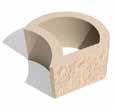





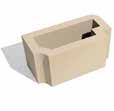




IMIESA June 2019 43 C EMENT & C ONCRETE
Creating space for new sports fields on a steep slope using Terraforce concrete retaining wall elements
Wheelchair ramps for student access
A ramp and staircase section, plus seating next to the hockey field
Gabion elements have been incorporated as part of the drainage design

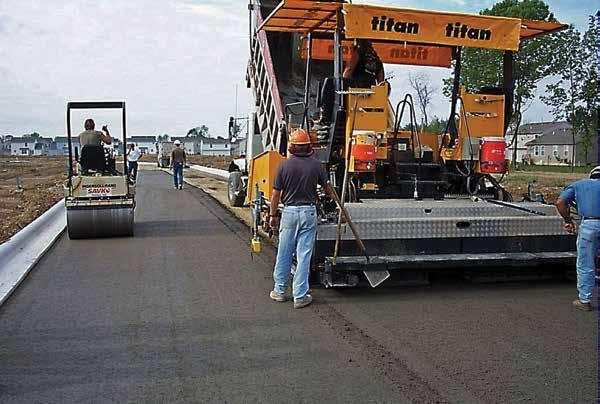
The potential and challenges of RCC
There’s an increasing global interest in rollercompacted concrete (RCC). bryan Perrie* takes a closer look at RCC’s unique qualities, while highlighting some of the challenges faced when using this construction material.
RCC is a zero-slump concrete that is transported, spread and compacted using large, earthmoving plant. For this reason, the technique is best suited for largerscale projects and mass concrete works.
Since the early 1980s, RCC has gained general acceptance as an appropriate material and method for the construction of dams, with hundreds of these large structures completed worldwide. It has also been successfully used for pavement construction in countries such as Canada, Spain and the USA.
During its early development, RCC was perceived as a low-quality, low-strength mass material. But it has since become possible to produce a wide range of concrete qualities by roller compaction, with the most common
abOVe RCCP is ideally suited for the provision of local community streets
product being a dense, high-quality and relatively high-strength concrete.
RCC for dams
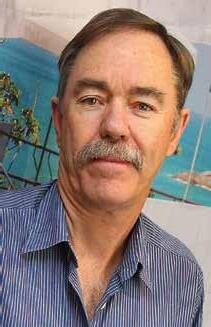
RCC for dams is generally a relatively lowstrength concrete, similar in strength to the material used in mass concrete dams. Experience and testing have demonstrated the properties of hardened RCC to be similar to those of conventional mass concrete. Differences are more apparent in the fresh state: in RCC, these relate primarily to lower water and cement contents, and a higher aggregate content.
With well-graded aggregates, adequate cement content and dense compaction, RCCP can achieve strength properties equal to those of conventional concrete
Differences in the hardened concrete include: • The volume change of RCC once set is reduced, as a result of less drying shrinkage
44 IMIESA June 2019
Bryan Perrie, managing director of The Concrete Institute
C EMENT & C ONCRETE
Rollers in action during the construction of an RCCP section

(due to less water in the mix), less heat of hydration (because of lower cement content), and a lower effective long-term temperature reduction.
• Creep is reduced as a result of lower total paste content, lower thermal stresses and an early capacity to carry low levels of compressive stress.
• Higher densities are achieved due to the use of continuously graded aggregates and tighter control on aggregate shape. Consequently, the total aggregate content is increased.
Pavements
Roller-compacted concrete pavement (RCCP) has not been widely used in South Africa. Some test sections were installed locally, predominantly in the 1980s and 1990s.

RCCP has similar strength properties to and consists of the same basic ingredients as conventional concrete pavements, but has different mix proportions. These strengths are generally significantly higher than those of RCC used in dam construction. Fresh RCCP is stiffer than typical zero-slump conventional concrete.
An asphalt-type paver equipped with a high-density screed is typically used during placement, followed by a combination of passes with compaction rollers. RCCP is constructed without forms, dowels or reinforcing steel. Joint sawing is not required, but when specified, cuts are spaced further apart than with conventional concrete
rcc pavementS are generally uSed for:
• Ports, intermodal facilities, and heavy industrial facilities
• Light industrial areas
• Airport maintenance areas and parking lots (unsurfaced RCCP is not recommended for aircraft traffic due to possible dislodging of loose aggregate particles)
• Major arterials, often with a diamond-ground surface or thin asphalt surfacing in higherspeed areas
• Low-volume rural roads
• Local community streets
• Widening of existing roads or provision of surfaced shoulders

pavements. RCCP can be and has been constructed by labour-intensive methods for low-volume roads.
With well-graded aggregates, adequate cement content and dense compaction, RCCP can achieve strength properties equal to those of conventional concrete. Achieving
EXCELLENCE IN WATERTIGHT CONCRETE

SIKA® WT-200P
The crystalline admixture enables concrete cracks to self-heal and therefore block water, even when under extreme hydrostatic pressure. It will continue to reactivate whenever water is present.
Benefits of using Sika® WT-200P in waterproof concrete:
Increase in service life of the construction
Significantly improved durability and sustainability of the hardened concrete
Ensured watertightness without other expensive measures
Reduced maintenance costs
Enhances the self-healing properties of concrete and promotes the ability to heal concrete cracks
www.sika.co.za
Get the Sika app and follow us on social media
C EMENT & C ONCRETE
a dense product is the key to ensuring good performance.
Cost savings and durability
The primary benefit of RCCP is that it can be constructed faster and more cost-effectively than conventional concrete pavement and some multiple-lift asphalt pavements. The actual cost saving depends on volumes and paving complexity.
Other benefits include:
• The lower paste content results in less shrinkage and reduced cracking.
• RCCP can be designed to have high flexural, compressive and shear strengths, enabling it to bear heavy repetitive loads without failure, and withstand highly concentrated loads.
• Its low permeability gives good durability and resistance to chemical attack.
• Costs related to joint maintenance can be eliminated or reduced.
• It shows good abrasion resistance under heavy traffic.
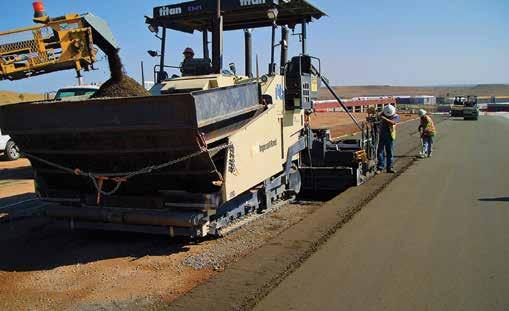
The primary benefit of RCCP is that it can be constructed faster and more costeffectively than conventional concrete pavement and some multiple-lift asphalt pavements
• Layer placements as thick as 250 mm are possible in a single lift, depending on the mix and equipment used.
Limitations
There are some limitations and challenges to using RCCP. These include a lack of smoothness and profile, which may not be suitable for high-speed traffic. This can be addressed by diamond grinding or a thin asphalt layer, though this adds to the cost.
Another consideration is that multiple lifts must be carefully planned to ensure a
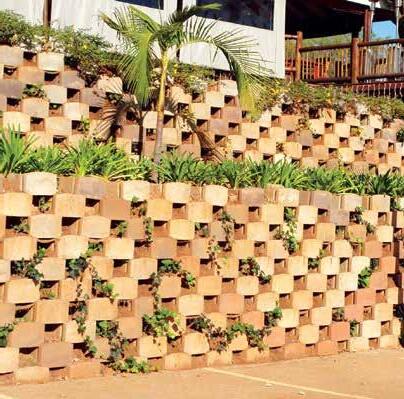





delay of less than an hour between lifts. Pavement edges are also difficult to compact adequately. Furthermore, it’s important to note that placing RCCP in hot weather requires extra protection and vigilance to minimise water loss caused by evaporation. In all other respects, it’s a highly versatile technique for diverse applications ranging from major arterials to low-volume rural roads.
*Bryan Perrie is the managing director of The Concrete Institute.
RETAINING VALUE
Technicrete has developed innovative, environmentally sound & cost-effective retaining wall solutions for multiple applications. A strong development and research process has allowed Technicrete to develop specialized precast concrete products that deal with highly technical, multi environmental issues that allow retaining walls to be not only functional but aesthetically pleasing too.
Application: Unique Products:
• Earth embankments
• Bridge abutments
• Cut slopes
• Steep channels
• River banks
• Culvert inlets/outlets
• Florawall (earth terrace retaining support)
• Earthform (natural support for terraces)
• Enviro-Wall & RocEnviro-Wall (retaining wall system)

46 IMIESA June 2019 C EMENT & C ONCRETE
Technicrete is a subsidiary of ISG, a leading supplier of innovative infrastructure products to the construction and mining markets in Southern Africa. Tel: 011 674 6900 Maxi call: 0861 266 267 www.technicrete.co.za paving | mining | masonry | kerbs erosion protection | retaining walls | drainage
Slagment is green
For over half a century, AfriSam has produced its tradenamed Slagment from ground granulated blast furnace slag (GGBFS). This latent hydraulic binder is used in an extensive range of concrete applications, including major structures such as dams, bridges and roads.
“Indeed, it is only very specific and limited applications that today demand our cement without added slag,” explains Hannes Meyer, cementitious executive, AfriSam. He highlights the self-cementing properties of slag, which can double the lifespan of buildings.
One of its key benefits is the countering of sulfate attack and alkalisilica reaction in concrete, especially in applications like wastewater treatment plants, or where there is seawater or sulfate-rich soil.
Another important capability of Slagment is to reduce the thermal heat gradient generated when pouring concrete. This reduces the likelihood of microcracking, which may weaken the structure’s strength. Slagment can also alter the colour of concrete to nearwhite by replacing 50% to 70% of the concrete, giving the concrete a better appearance. In addition, it produces a smoother, more defect-free surface.
“However, there is now an added consideration in business today, as companies anticipate the impact of the new carbon tax,” he says. “Slagment assumes a significance here, too, as it reduces the amount of clinker in concrete, cutting the energy consumed and carbon emitted in its manufacture. The use of Slagment, therefore, presents not just a technical solution, but an opportunity to achieve higher environmental standards.”
AfriSam’s dedicated Slagment plant in Vanderbijlpark has the capacity to produce over 800 000 t of slagment a year, along with over 200 000 t of blended cementitious products. The slag is a by-product of the steel and iron industry, and the plant mills this to a fine consistency before blending.
“As part of AfriSam’s sustainability journey, we have implemented various strategies in response to the energy intensity of the cement manufacturing process,” says Meyer.
“Slagment remains a vital part of this journey, and we continue to develop innovative ways of extending its benefits to customers,” he concludes.
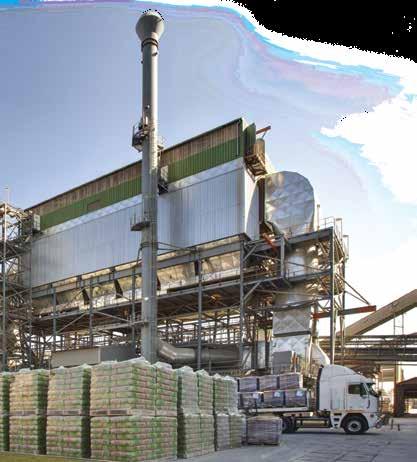
IFAT Africa 2019
Gallagher Convention Centre, Midrand Africa ' s leading trade fair for water, sewage,

Don’t
miss Africa ' s leading trade fair for water,
sewage,
refuse and recycling !
IFAT Africa brings together industry leaders across the water, sewage, refuse and recycling, as well as the food & drink and analytics industries, to showcase the latest in technologies, processes and thought leadership. Visit IFAT Africa for:
• Advanced technologies and solutions by over 100 top local and international brands
• International innovations and trends precisely tailored to the local market
• Master classes on topical issues
• Networking with up to 6,000 stakeholders across related sectors
Trade fair for water, sewage, refuse & recycling July 9 - 11, 2019 • Johannesburg
Bringing together partners for the Southern African market in the analytics, food & beverage and environmental technology, we are proudly co-located with:



Connecting Global Competence
food & drink
technology Africa
REGISTER NOW AT www.ifat-africa.com In partnership with C M Y CM MY CY CMY K
refuse and recycling.

INSURANCE THAT SPECIALISES IN YOUR CONSTRUCTION PROJECTS
Every project you undertake requires your full attention. At Old Mutual Insure, we understand your needs; that’s why we have the right cover for you. It’s simple. It’s convenient. It’s efficient. With our experience and specialist expertise, you’ll know that you can count on us.
The great things you do tomorrow start with the small steps you take today. Take that step with Old Mutual Insure. The time is now.
Speak to your broker or visit ominsure.co.za to take that first step.
48 IMIESA June 2019
All products are underwritten by Old Mutual Insure, an Authorised Financial Services Provider (FSP 12) DO GREAT THINGS EVERY DAY INSURE 119263L/E

Engineering and construction insurance in a challenging market
Sustaining a business in an economy under prolonged pressure is a challenge. Add the risks associated with the engineering and construction sector, and it’s no surprise that many companies are closing or scaling down, and mining operations are showing contraction.
According to Michael Steensma, senior manager: Engineering at Old Mutual Insure, this situation is largely due to delays in contracts being awarded, as companies go into business rescue owing to the poor economic climate. “Insurers should expect their clients to downsize portfolios,” he states.
Risks for insurers and the insured
The biggest risks for insurers in the engineering and construction sector include contract types, location, and lack of skills – combined with fire, theft (particularly where copper cabling is involved), riots and strikes. “Furthermore, we are moving into an era where climate change is a reality and needs to be considered by the insured and insurers,” says Steensma.
For the insured, the risks include failing to cover free-issue materials in their policies. These are the materials given to the contractor free of charge (not catered for in terms of the bill of quantities) for incorporation into the project and must be included in the sum insured.
“Some clients forget or fail to insure their surrounding property
exposures correctly,” says Steensma. This would cover employers’ property in the care, custody and control of the contractor against damage caused by construction activities. Another consideration to take into account is covering delays in start-up. “This is available for employer-controlled projects to cover the loss of profits, revenue or rental in the event that the project is not completed in time due to an insurable event such as fire damage,” he says.
Tailored insurance solutions
According to Steensma, a tailored insurance solution across a number of lines of business associated with construction projects could mitigate risks. “Our Construction Risks policy provides cover to our customers for their construction projects not only for loss or damage to the works but also the thirdparty losses arising from the performance of the project, from the time they break
ground until the project is completed and handed over. The policy includes the works and liability covers during the defects liability period.”
Future engineering and construction insurance opportunities
Steensma sees the increase in infrastructure and housing projects, due to urbanisation, providing key opportunities for insurers. “Another opportunity would come from the replacement of ageing infrastructure (roads and services) and renewable energy.”
To meet these opportunities, the insurance industry needs to innovate and adapt. “One way we have done this is by providing a single product for megaprojects that require cover from the marine stage through to construction and then operational cover, including liability exposures.”
Steensma further suggests increasing the emphasis on actuarial and computerbased risk modeling to better understand and evaluate risk exposures at any stage of a project. “Future clients will expect to do business quicker, easier and more efficiently, promoting the need to review our distribution channels.” He cites the business information modeling process, which is being implemented by the larger construction companies, as a good example.
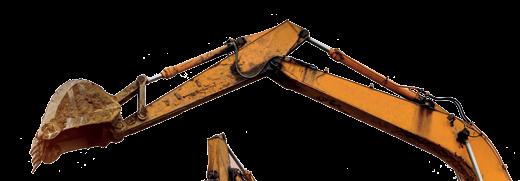
“An increase in technology could lead to improvements in efficiency and potentially make a risk more attractive,” concludes Steensma.
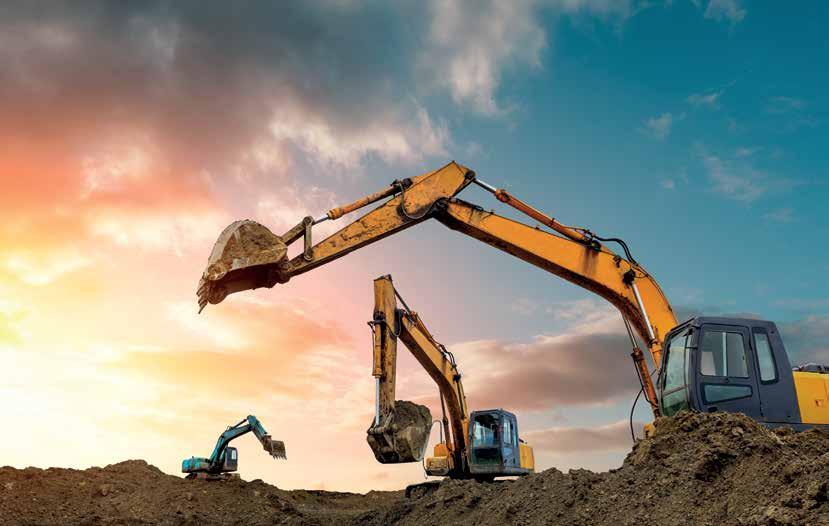
I NS u R a NCE
IMIESA June 2019 49
Sustainability Week 2019 will showcase innovation like never before
This multi-faceted and integrated event will educate and inspire attendees to pave the way for a better, more sustainable future.
Multiple platforms will highlight the actions and interventions of thought leaders, policymakers, consumers, various organisations and investors, as they raise the benchmark on providing sustainable solutions to global and national challenges.
With a stellar line-up of speakers and topics, Sustainability Week 2019 is guaranteed to set minds light with ideas.















24 - 26 JUNE 2019 CSIR INTERNATIONAL CONVENTION CENTRE
CONTACT DAVID ITZKIN 021 681 7000 ∙ David.izkin@alive2green.com www.sustainabilityweek.co.za "Green Economy drives sustainable growth in SA and Africa" EXHIBITORS SPONSORS& PARTNERS
Screencore launches in SA
Wirtgen South Africa has been appointed as the exclusive local distributor for Northern Ireland-based OEM Screencore, which manufactures a range of mobile screens and stockpilers.
Screencore machines are designed to work in a wide range of applications, including quarrying, mining, recycling, earthmoving, organics and agriculture. Tracked conveyors range from 65 to 100 feet, while the wheeled series extends from 30 to 80 feet.
One of the first units to be unveiled in South Africa is the Screencore 365R, a 65 foot radial, tracked stockpiler with a C2.2 Turbo Cat engine and a 300 tonne per hour (tph) capacity. This will be joined by several other models in the near future. These include the 480R, an
The radial function on the Screencore 480R can be controlled by timer, sensors and/or radio remote
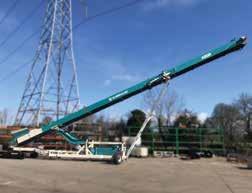
80 foot radial, tracked unit with a 1 200 mm wide belt and a 600 tph capacity. The 365R is Screencore’s most popular radial stacker, allowing for massive stockpiling capacity and ultimate flexibility. The quick-change facility from tracking to radial mode ensures minimum set-up time after arrival on-site.
“Over 90% of the Screencore range is designed to fit in a shipping container.
The Screencore 365R is a 65 foot radial, tracked stockpiler
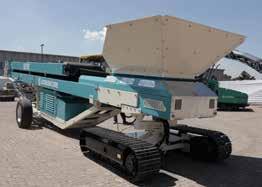
Therefore, they fold to a very compact size, making them simple to move from site to site,” comments Ciarán Ryan, sales manager, Screencore.
“Additionally, the use of quality components such as Cat engines and our state-of-the-art production facility in Ireland ensure that these units deliver the highest levels of performance and reliability,” Ryan concludes.
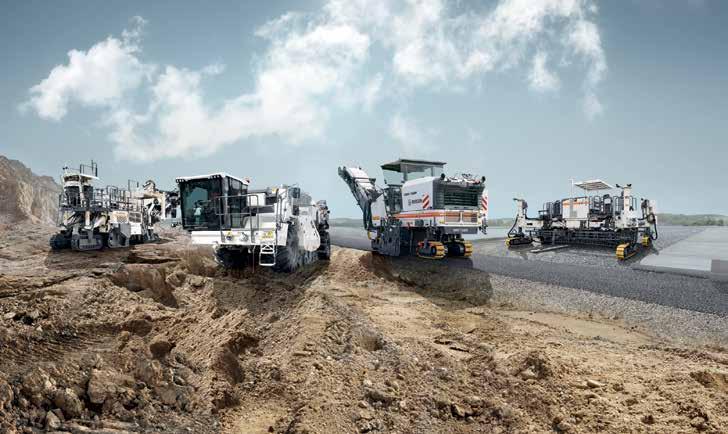
IMIESA June 2019 51 T R a NSPORT, lO g ISTICS , vE h IC l ES & Equ IPMENT www.wirtgen.com/mining WIRTGEN SOUTH AFRICA (Ptv) Ltd. 52 Maple Street Pomona Kempton Park 1619 South Africa T: +27 11 452 1838 A WIRTGEN GROUP COMPANY
for your success. WIRTGEN supplies a complete range of mobile machines and high-quality services for all areas of road construction and open-cast mining. With its innovative, high-performance and cost-efficient products and technologies for cold milling, soil stabilization, hot and cold recycling, concrete paving and surface mining, WIRTGEN leads the world market in road construction and repair, as well as in mining natural rock and pay minerals. We develop both the machines and the technology. Take advantage of innovative solutions from the market and technology leader! www.wirtgen-group.com/southafrica WIRTGEN Südafrika_W_PRODUCT-DIVISIONS_180x130mm.indd 1 30.01.19 17:18
Innovative solutions









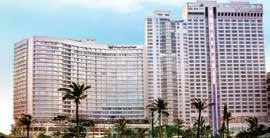
ACCOMMODATION
Special rates have been negotiated for IMESA delegates. Book NOW and quote the unique booking code found on the IMESA Conference website.
EARLY BIRD REGISTRATION
Register and pay BEFORE 28 June 2019
• Members: R6 100
• Non-members: R7 300
STANDARD REGISTRATION
Register and pay AFTER 29 June 2019
• Member: R6 900
• Non Member: R8 100
GOLF
R520, excl. Golf cart and caddy
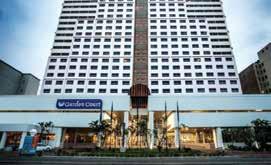

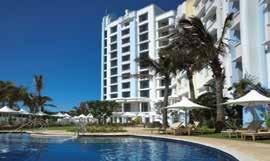
TRANSPORT
IMESA will be providing FREE airport and daily shuttle or transport services for all attending the Conference. NOTE: Daily shuttle or transport services will ONLY run to and from the hotels listed on this advert.


FROM: R1 380 SUNCOAST TOWERS 2.3 km
COMPANION TOUR
FROM: R1 600 FROM: R1 445 FROM: R780 FROM: R1 380 FROM: R1 230 HILTON HOTEL Onsite CITY LODGE DURBAN 550 m FROM: R1 230 GARDEN COURT MARINE PARADE 1.7 km ROAD LODGE 1.1 km SOUTHERN SUN ELANGENI MAHARANI 1.1 km GARDEN COURT UMHLANGA 17 km
R1 100 per person
FROM: R1 230 GARDEN COURT SOUTH BEACH 1.8 km IMESA ORGANISER THE INSTITUTE OF MUNICIPAL ENGINEERING OF SOUTHERN AFRICA (IMESA) TEL: 031 266 3263 DEBBIE OR MELANIE CONFERENCE ENDORSED BY t +27 (031)266 3263 e conference@imesa.org.za conference.imesa.org.za Book online now DURBAN INTERNATIONAL CONVENTION CENTRE 83 RD IMESA CONFERENCE 02-04 October 2019
MUNICIPAL CHALLENGES
CONQUERING
Custom-built plant boosts capacity
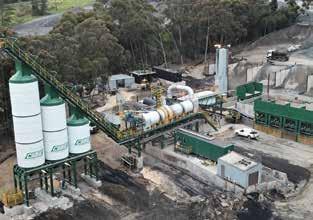

Western Cape asphalt producer
More Asphalt has almost doubled production capacity at its Tygerberg Valley site outside Cape Town, with a custom-built continuous-mix asphalt plant from Comar. Starting production in October 2018, the facility impressed its owners by exceeding operating expectations and producing 100 000 tonnes in its first seven months.
Space savings were achieved through the design and installation of a single combination drying and mixing drum in a counterflow configuration, incorporating a longnose burner.
The new plant includes six cold feed bins for sand and aggregate, and two recycled asphalt pavement bins for fine and coarse fragment sizes. A baghouse for catching dust particulate emissions, as well as a state-of-the-art motor control centre in a 12 m shipping container are also key elements of the new plant.
“The facility uses a higher-quality fuel than normal, providing better combustion and less sulfur burn-off,” says De Wet Dreyer, operations manager, Comar. “Among the benefits of this fuel choice are the longer bag life and reduced maintenance costs for the overall operation.”
Emissions compliant
As a result, the plant complies comfortably with new emissions standards on dust particulate levels, which may not exceed 50 mg/Nm3. A recent inspection of the plant confirmed it was dealing well with the high production volumes, showing little wear on the lifters and also minimal wear in the bags, which were operating highly efficiently. The design provides for additional loadout flexibility should the customer require it. This allows for a fourth product to be discharged directly on to trucks, while the three silos are filled.






“Leadership and innovation to preserve and enhance the value of the region’s roads within a rapidly changing world.”



IMIESA June 2019 53
For more on CAPSA sponsorship and exhibition, please visit www.capsaconference.co.za or contact us: Scatterlings Conference & Events: Sponsorship and Exhibition Robyn Cawood – robyn@soafrica.com | +27 11 463 5085 Dr. Thierry
FEHRL - Europe’s National Road Research Centres Secretary General of FEHRL
Goger
Royal Dutch Shell General Manager Specialities Europe & Africa MEET OUR KEY-NOTE SPEAKERS 37 STANDS BOOKED 80 COMPANIES REGISTERED 20 SPONSORS 73 PAPERS SUBMITTED BOOK YOUR SPACE TODAY! LIMITED SPONSORSHIP OPPORTUNITIES AVAILABLE.
Prof. Bill Buttlar Glen Barton Chair of Flexible Pavement Technology University of Missouri
Dr Audny van
Helden
An aerial view of the new Comar asphalt plant at More Asphalt
CASE Construction
Equipment’s range of full-size F-series wheel loaders have advanced features for faster operation, higher productivity, lower fuel consumption and improved on-site safety.
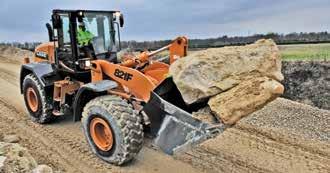
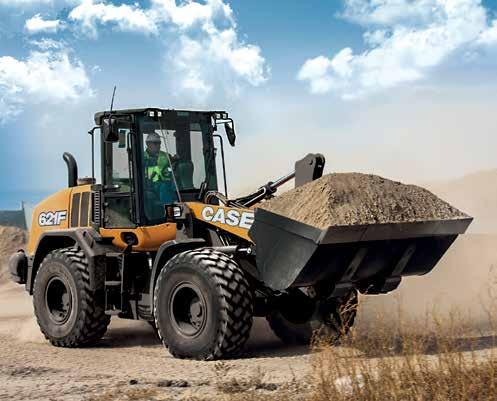
Stronger and faster
The F-series wheel loaders, with reduced emissions, offer increased power ratings, additional lifting capacity and greater breakout force,” says Ross Collard, managing director, CASE Construction Equipment SA.
Four F-series models are available locally, namely the 621F, 821F, 921F and 1021F. The 1021F is powered by an 8.7-litre engine, while the remaining three units are fitted with a 6.7-litre power plant.
All machines are equipped with a standard four-speed transmission with a lock-up torque converter for improved acceleration and safe hill climbing. The trademarked Powerinch declutching feature ensures accuracy and control when operating in tight settings, especially during truck loading. These machines are also available with XR (extended reach) linkage for a greater dump height and versatility.
The operator has four work modes to choose from (Economy, Standard, Auto and Maximum Power) for optimum efficiency in any application. Benefits include better use of available power, lower fuel consumption, reduced wear on the engine and driveline, lower noise levels, and lower overall emissions.
Advanced cooling
On CASE F-series wheel loaders, the cooling module is now fitted higher in the chassis for improved performance and reduced running costs. This system, with an auto or manual reverse fan that clears dust and debris from the radiator fin, maintains temperatures at an optimum level for extended component life.
An open differential on the front and rear axles also prevents overheating, and a differential lock on the front axles provides effective grip control on any surface, particularly on soft soil where greater resistance is needed. A low-effort, singlelever loader control joystick incorporates
Like its F-series counterparts, the Case 621F features advanced engine technology, an efficient transmission, high-productivity differential and axles, a low-maintenance cooling design, and enhanced ergonomics
a quick shuttle switch for faster, more precise operations. The operator chooses the working mode from within the cab, or the autopower facility can be selected, which automatically matches the power curve to each application. All controls have been designed to be highly responsive to commands and digital displays enable clear reading in all lighting conditions.
Engine diagnostics are done inside the cab, enabling the quicker detection of service needs. Maintenance is also made easy with a full raise-up hood, environmentally safe fluid drains, sight gauges and grouped, ground-level checkpoints.
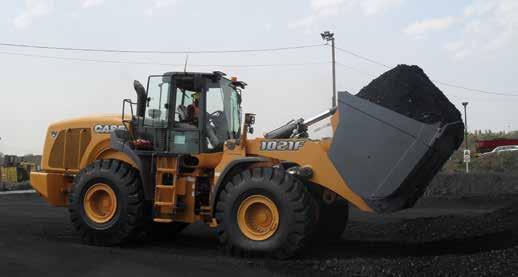
T R a NSPORT, lO g ISTICS , vE h IC l ES & Equ IPMENT
54 IMIESA June 2019
The Case 1021F wheel loader has an operating weight of approximately 24 399 kg
The 821F wheel loader has an articulated tipping capacity of around 9 934 kg
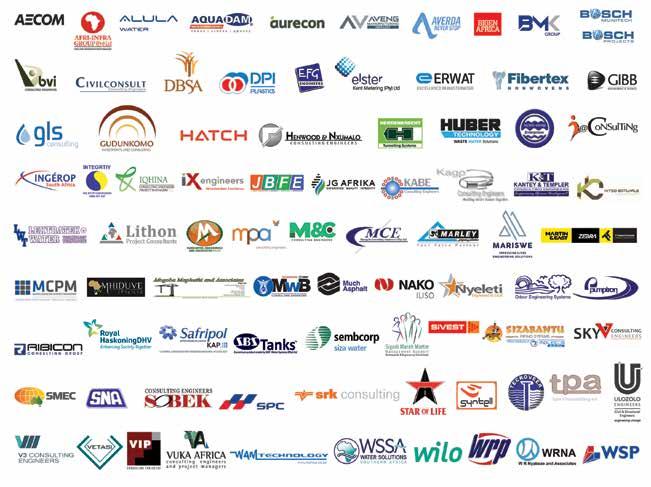
PROFESSIONAL AFFILIATES
AECOM siphokuhle.dlamini@aecom.com
Afri-Infra Group (Pty) Ltd banie@afri-infra.com
ALULA (Pty) Ltd info@alulawater.co.za
AQUADAM (Pty) Ltd sales@aquadam.co.za
Aurecon Fani.Xaba@aurecongroup.com
Aveng Manufacturing Infraset werner.booyens@infraset.com
Averda claude.marais@averda.com
Bigen Africa Group Holdings otto.scharfetter@bigenafrica.com
BMK Group brian@bmkgroup.co.za
Bosch Munitech info@boschmunitech.co.za
Bosch Projects (Pty) Ltd mail@boschprojects.co.za
BVI Consulting Engineers marketing@bviho.co.za
Civilconsult Consulting Engineers mail@civilconsult.co.za
Corrosion Institute of Southern Africa secretary@corrosioninstitute.org.za Development Bank of SA divb@dbsa.org.za
DPI Plastics Farhana@dpiplastics.co.za
EFG Engineers eric@efgeng.co.za
Elster Kent Metering Leonardus.Basson@honeywell.com
ERWAT mail@erwat.co.za
Fibertex South Africa (Pty) Ltd maru@fibertex.co.za
GIBB marketing@gibb.co.za
GIGSA secretary@gigsa.org
GLS Consulting nicky@gls.co.za
Gudunkomo Investments & Consulting info@gudunkomo.co.za
Hatch Africa (Pty) Ltd info@hatch.co.za
Henwood & Nxumalo Consulting Engineers (Pty) Ltd pmboffice@hn.co.za
Herrenknecht schiewe.helene@herrenknecht.de
Huber Technology cs@hubersa.com
Hydro-comp Enterprises info@edams.co.za
I@Consulting info@iaconsulting.co.za
INGEROP mravjee@ingerop.co.za
Integrity Environment info@integrityafrica.co.za
IQHINA Consulting Engineers & Project Managers info@iqhina.co.za
iX engineers (Pty) Ltd hans.k@ixengineers.co.za
JBFE Consulting (Pty) Ltd issie@jbfe.co.za
JG Afrika DennyC@jgafrika.com
KABE Consulting Engineers info@kabe.co.za
Kago Consulting Engineers kagocon@kago.co.za
Kantey & Templer (K&T) Consulting Engineers ccherry@ctokamteys.co.za
Kitso Botlhale Consulting Engineers info@kitsobce.co.za
Lektratek Water general@lwt.co.za
Lithon Project Consultants (Pty) Ltd info@lithon.com
Makhaotse Narasimulu & Associates mmakhaotse@mna-sa.co.za
Malani Padayachee & Associates (Pty) Ltd admin@mpa.co.za
M & C Consulting Engineers (Pty) Ltd info@mcconsulting.co.za
Maragela Consulting Engineers admin@maragelaconsulting.co.za
Marley Pipe Systems info@marleypipesystems.co.za
Mariswe (Pty) Ltd neshniec@mariswe.com
Martin & East
gbyron@martin-east.co.za
Masithu Consulting & Project Management info@mcpm.co.za
Mhiduve adminpotch@mhiduve.co.za
Mogoba Maphuthi & Associates (Pty) Ltd admin@mmaholdings.co.za
Moedi Wa Batho Consulting Engineers (Pty) Ltd info@wabatho.co.za
Much Asphalt bennie.greyling@muchasphalt.com
NAKO ILISO lyn.adams@nakogroup.com
Nyeleti Consulting merasmus@nyeleti.co.za
Odour Engineering Systems mathewc@oes.co.za
Pumptron randall@gormanrupp.co.za
Ribicon Consulting Group (Pty) Ltd info@ribicon.co.za
Royal HaskoningDHV francisg@rhdv.com
SABITA info@sabita.co.za
SAFRIPOL mberry@safripol.com
SALGA info@salga.org.za
SAPPMA admin@sappma.co.za / willem@sappma.co.za
SARF administrator@sarf.org.za.co.za
SBS Water Systems mava@sbstanks.co.za
Sembcorp Siza Water info-sizawater@sembcorp.com
Sigodi Marah Martin Management Support lansanam@sigodimarah.co.za
SiVEST SA garths@sivest.co.za
Sizabantu Piping Systems (Pty) Ltd gregl@sizabantupipingsystems.com
SKYV Consulting Engineers (Pty) Ltd kamesh@skyv.co.za
SMEC capetown@smec.com
SNA stolz.j@sna.co.za
Sobek Engineering gen@sobek.co.za
Southern African Society for Trenchless Technology director@sasst.org.za
Southern Pipeline Contractors (Pty) Ltd spc@vinci-construction.com
SRK Consulting jomar@srk.co.za
STAR OF LIFE EMERGENCY TRADING CC admin@staroflife.co.za
Syntell julia@syntell.co.za
TECROVEER (Pty) Ltd info@tecroveer.co.za
TPA Consulting roger@tpa.co.za
Ulozolo Engineers CC admin@ulozolo.co.za
V3 Consulting Engineers (Pty) Ltd info@v3consulting.co.za
Vetasi south-africa@vetasi.com
VIP Consulting Engineers esme@vipconsulting.co.za
VUKA Africa Consulting Engineers info@vukaafrica.co.za
Water Institute of Southern Africa wisa@wisa.org.za
WAM TECHNOLOGY CC support@wamsys.co.za
Water Solutions Southern Africa ecoetzer@wssa.co.za
Wilo South Africa marketingsa@wilo.co.za
WRP ronniem@wrp.co.za
WRNA washy@wrnyabeze.com
WSP Group Africa ansia.meyer@wsp.com
IMESA AFFILIATE MEMBERS
IMESA


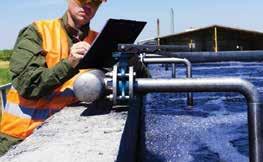


INDE x TO a D v ERTISERS Alive2Green 50 CAPSA 53 Clay Brick Association of South Africa 14 ECM Technologies 20 ERWAT IFC Evalution Flooring 17 Gabion Baskets 22 Grundfos 4 Hall Longmore 25 IFAT Africa 47 IMESA 16, 52, 55 Martin & East 42 Mather+Platt 37 Nyeleti Administration Trust 10 Old Mutual 48 Quality Filtration Systems 13 SA Leak Detection OFC, 8 SAPPMA 30 Semane Engineering Solutions OBC Sika 45 Sizabantu Piping Systems IBC SMEC South Africa 33 Southern African Transport Conference 56 Southern Pipeline Contractors 38 Steel Tube Export Association of SA 26 Structa 24 Technicrete 46 Terraforce 43 Trenchless Technologies 41 Utility Systems 2 Wirtgen 51 56 IMIESA June 2019 SATC_Print advert_210x148.5_print.pdf 1 2019/05/21 09:57


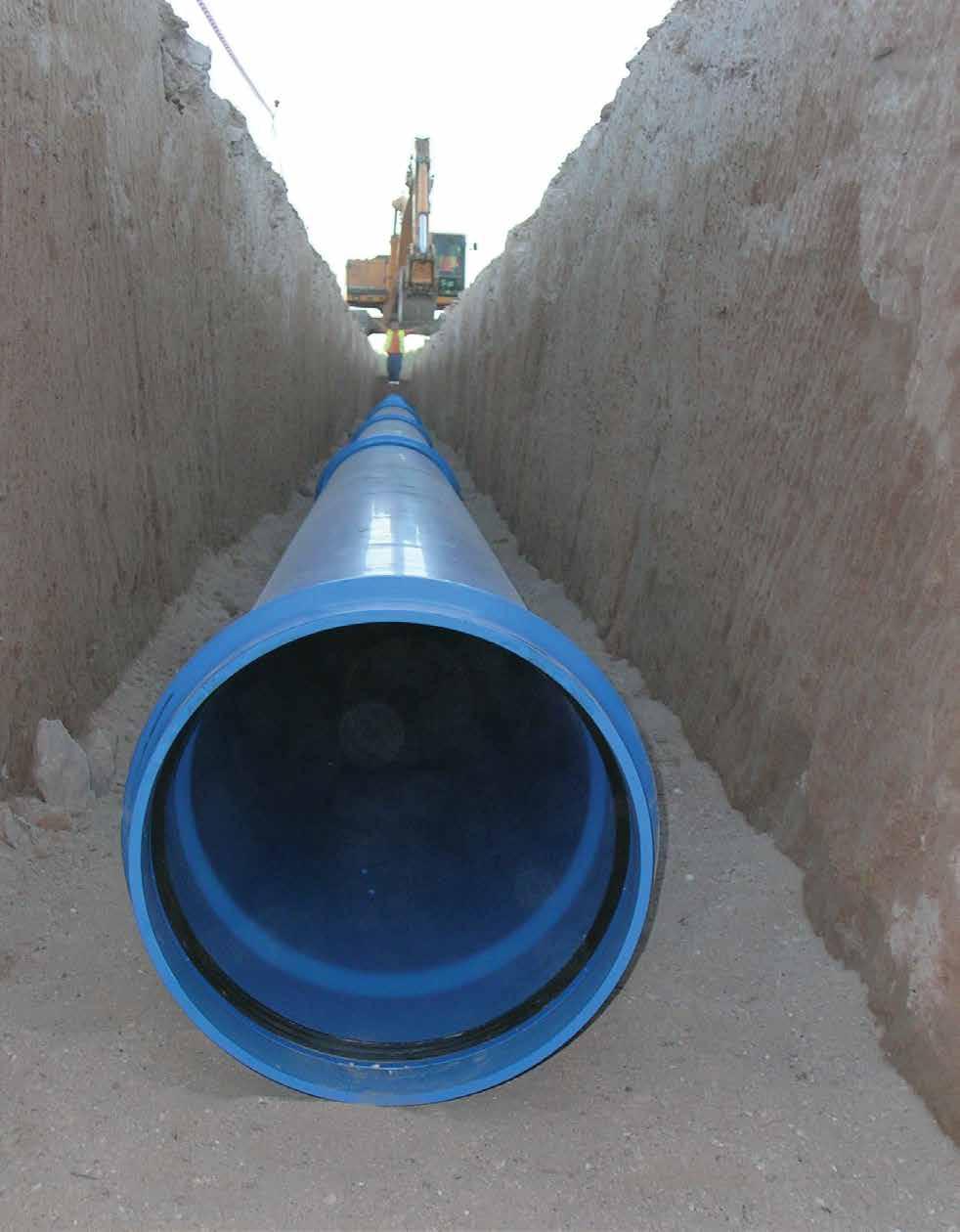
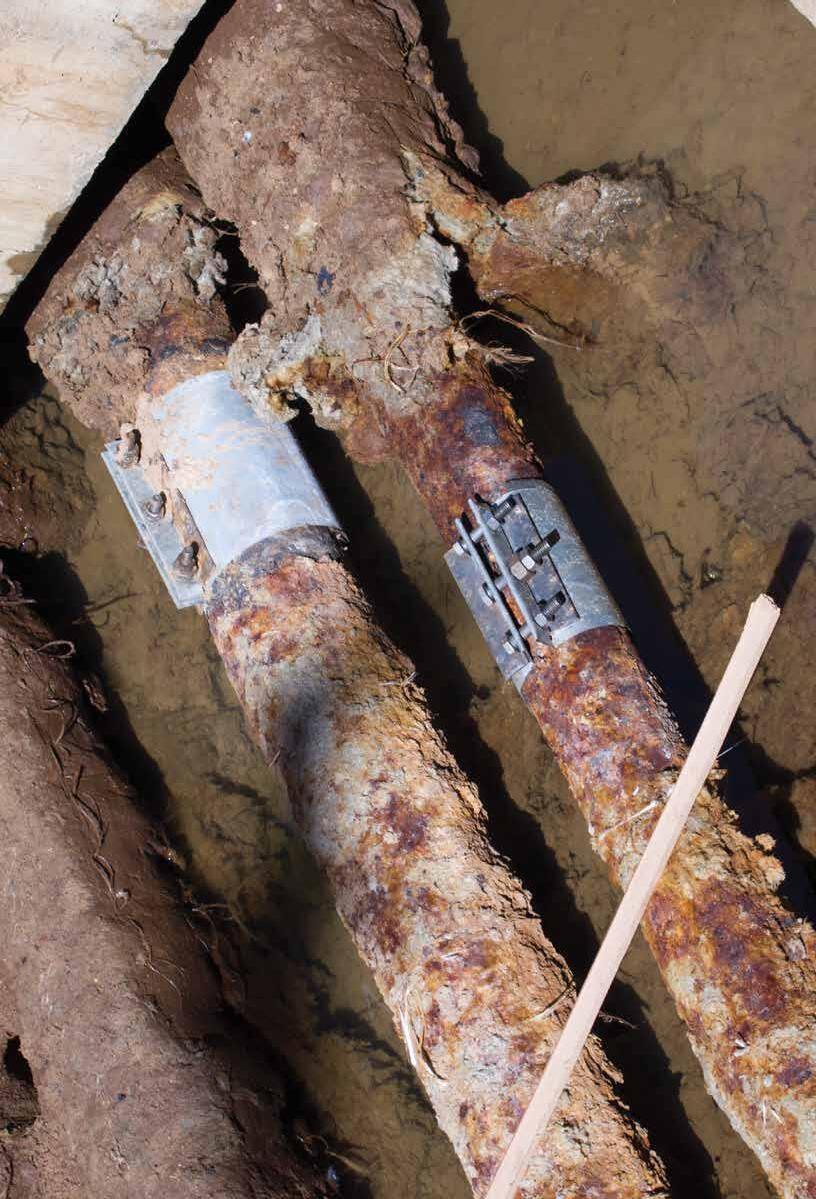


www.sizabantupipingsystems.com
Designedfor peaceofmind.
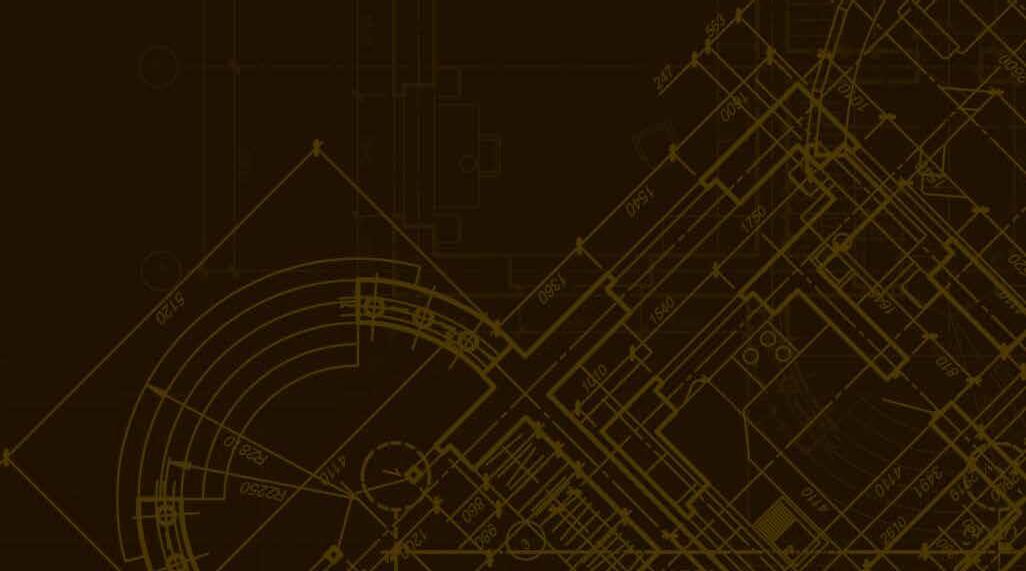

Any mining and public infrastructure project is, in a way, a monument to a team of pioneering people who, knowing the risks and complexities ahead, nevertheless choose to bring it into existence. When they take that leap of faith, our twenty years of engineering solutions and industry knowledge matters a great deal to them. What matters even more is that everything we do is designed for peace of mind.

Engineering Solutions
Semane Engineering Solutions (Pty) Ltd is a majority Black-owned, independent South African provider of multi-disciplinary engineering solutions in mining and public infrastructure. We are a trusted advisor for civil infrastructural, civil structural, electrical and industrial automation (control and instrumentation) engineering solutions, project management, as well as geotechnical and environmental solutions. To find out more about us or to get in touch, please visit our website at www.semane.co.za.













































































 IMIESA June 2019 13
IMIESA June 2019 13




























































































































 Marcus Thulsidas, director: Business Development, Utility Systems
Marcus Thulsidas, director: Business Development, Utility Systems








































































































